Motorola Solutions 99FT5010 UHF 800/900 MOBILE RADIO User Manual UG XPR4580 DM
Motorola Solutions, Inc. UHF 800/900 MOBILE RADIO UG XPR4580 DM
Contents
- 1. Users Manual 1
- 2. Users Manual 2
Users Manual 1

Professional Digital Two-Way Radio System
XPR™ 4580
Display Mobile
User Guide
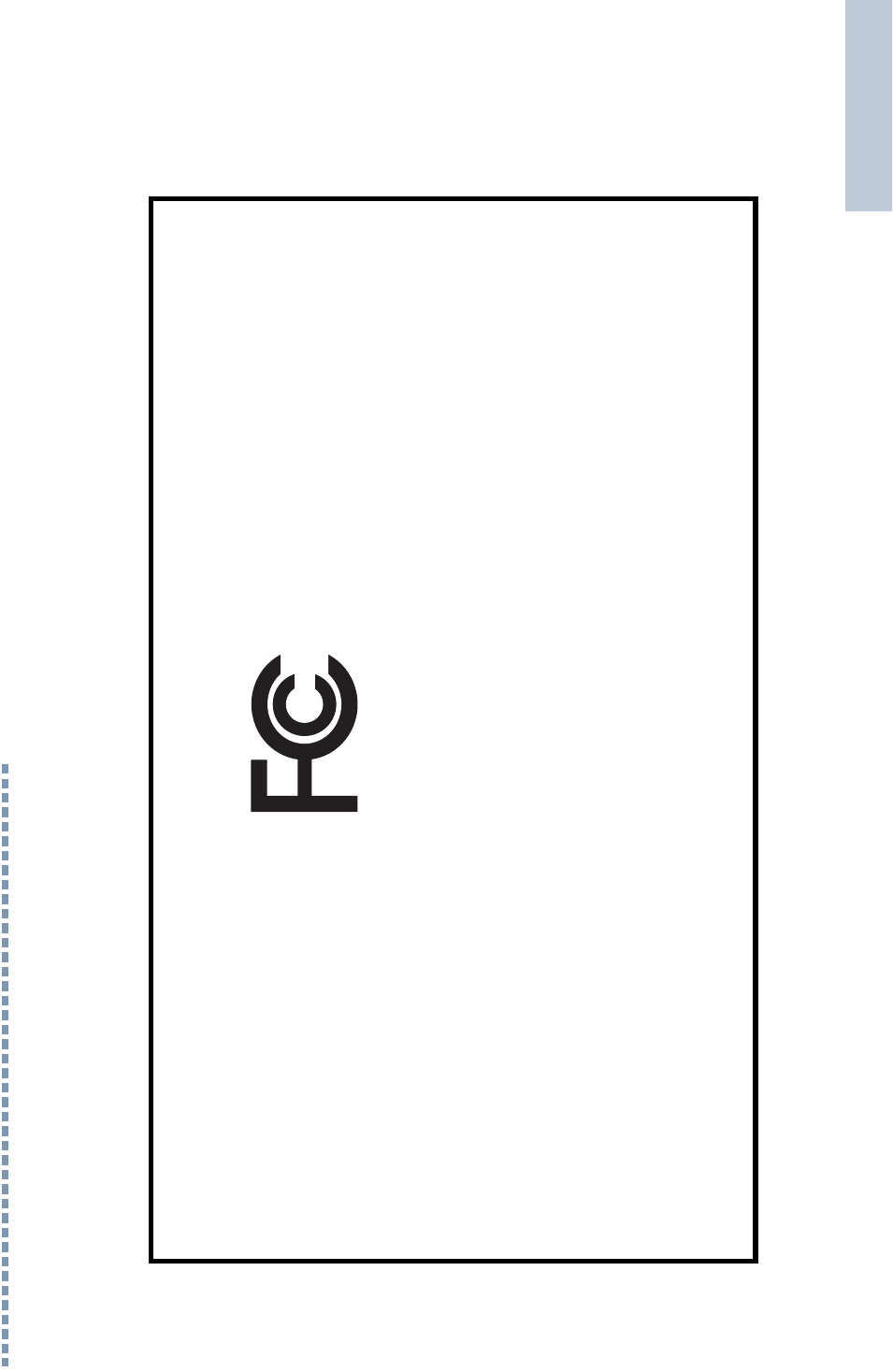
Declaration of Conformity
English
i
Declaration of Conformity
This declaration is applicable to your radio only if your radio is labeled with the FCC logo shown below.
DECLARATION OF CONFORMITY
Per FCC CFR 47 Part 2 Section 2.1077(a)
Responsible Party
Name: Motorola, Inc.
Address: 1301 East Algonquin Road, Schaumburg, IL 60196-1078, U.S.A.
Phone Number: 1-800-927-2744
Hereby declares that the product:
Model Name: XPR 4580
conforms to the following regulations:
FCC Part 15, subpart B, section 15.107(a), 15.107(d) and section 15.109(a)
Class B Digital Device
As a personal computer peripheral, this device complies with Part 15 of the FCC Rules. Operation is subject to the
following two conditions:
1. This device may not cause harmful interference, and
2. This device must accept any interference received, including interference that may cause undesired operation.

Declaration of Conformity
English
ii
Note: This equipment has been tested and found to comply with the limits for a Class B digital device, pursuant to part
15 of the FCC Rules. These limits are designed to provide reasonable protection against harmful interference in a
residential installation. This equipment generates, uses and can radiate radio frequency energy and, if not
installed and used in accordance with the instructions, may cause harmful interference to radio communications.
However, there is no guarantee that interference will not occur in a particular installation.
If this equipment does cause harmful interference to radio or television reception, which can be determined by
turning the equipment off and on, the user is encouraged to try to correct the interference by one or more of the
following measures:
•Reorient or relocate the receiving antenna.
•Increase the separation between the equipment and receiver.
•Connect the equipment into an outlet on a circuit different from that to which the receiver is connected.
•Consult the dealer or an experienced radio/TV technician for help.

Contents
English
iii
Contents
This User Guide contains all the information you need
to use the MOTOTRBO XPR Series Digital Mobile
Radios.
Declaration of Conformity . . . . . . . . . . . . . . . . . . . . . i
Notes . . . . . . . . . . . . . . . . . . . . . . . . . . . . . . . . . . . . . vi
Important Safety Information . . . . . . . . . . . . . . . . . vii
Product Safety and RF Exposure Compliance . . vii
Software Version . . . . . . . . . . . . . . . . . . . . . . . . . . . vii
Computer Software Copyrights . . . . . . . . . . . . . . viii
Getting Started . . . . . . . . . . . . . . . . . . . . . . . . . . . . . . 1
How to Use This User Guide . . . . . . . . . . . . . . . . . . 1
What Your Dealer/System Administrator Can Tell
You . . . . . . . . . . . . . . . . . . . . . . . . . . . . . . . . . . . . . . 1
Powering Up the Radio . . . . . . . . . . . . . . . . . . . . . . . 2
Adjusting the Volume . . . . . . . . . . . . . . . . . . . . . . . . 2
Identifying Radio Controls . . . . . . . . . . . . . . . . . . . . 3
Radio Controls You Will Be Using . . . . . . . . . . . . . . 3
Programmable Buttons . . . . . . . . . . . . . . . . . . . . . . . 4
Assignable Radio Functions . . . . . . . . . . . . . . . . . 4
Assignable Settings/Utility Functions . . . . . . . . . . . 5
Accessing the Programmed Functions . . . . . . . . . . . 5
Push-To-Talk (PTT) Button . . . . . . . . . . . . . . . . . . . . 6
Switching Between Conventional and Trunking
Mode . . . . . . . . . . . . . . . . . . . . . . . . . . . . . . . . . . . . . 6
Identifying Status Indicators . . . . . . . . . . . . . . . . . . . 7
Display Icons . . . . . . . . . . . . . . . . . . . . . . . . . . . . . . . 7
Call Icons . . . . . . . . . . . . . . . . . . . . . . . . . . . . . . . . . 8
Main Menu Icons . . . . . . . . . . . . . . . . . . . . . . . . . . . . 8
In-Menu Icons . . . . . . . . . . . . . . . . . . . . . . . . . . . . . . 8
LED Indicators . . . . . . . . . . . . . . . . . . . . . . . . . . . . . 9
Audio Tones . . . . . . . . . . . . . . . . . . . . . . . . . . . . . . . 9
Receiving and Making Calls . . . . . . . . . . . . . . . . . . 10
Selecting a Zone . . . . . . . . . . . . . . . . . . . . . . . . . . . 10
Selecting a Radio Channel . . . . . . . . . . . . . . . . . . . 11
Receiving and Responding to a Radio Call . . . . . . 11
Receiving and Responding to a Group Call . . . . . 11
Receiving and Responding to a Private Call . . . . 12
Receiving and Responding to a Phone Call . . . . 13
Making a Radio Call . . . . . . . . . . . . . . . . . . . . . . . . 13
Making a Call with the Channel Rocker . . . . . . . . 14
Making a Group Call . . . . . . . . . . . . . . . . . . . . . 14
Making a Private Call . . . . . . . . . . . . . . . . . . . . 14
Making an Enhanced Private Call . . . . . . . . . . 15
Making a Phone Call . . . . . . . . . . . . . . . . . . . . 15
Sending a Status Call . . . . . . . . . . . . . . . . . . . . 16
Using the Dynamic Regrouping Feature . . . . . 17

Contents
English
iv
Talkaround . . . . . . . . . . . . . . . . . . . . . . . . . . . . . . . 17
Permanent Monitor . . . . . . . . . . . . . . . . . . . . . . . . . 18
Advanced Features . . . . . . . . . . . . . . . . . . . . . . . . . 19
Scan Lists . . . . . . . . . . . . . . . . . . . . . . . . . . . . . . . . 19
Viewing an Entry in the Scan List . . . . . . . . . . . . 19
Editing the Scan List . . . . . . . . . . . . . . . . . . . . . . 19
Adding a New Entry to the Scan List . . . . . . . . 19
Deleting an Entry from the Scan List . . . . . . . . 20
Setting and Editing Priority for an Entry in the
Scan List . . . . . . . . . . . . . . . . . . . . . . . . . . . . . 20
Scan . . . . . . . . . . . . . . . . . . . . . . . . . . . . . . . . . . . . 21
Starting and Stopping Scan . . . . . . . . . . . . . . . . 21
Responding to a Transmission During a Scan . . 22
Deleting a Nuisance Channel . . . . . . . . . . . . . . . 22
Restoring a Nuisance Channel . . . . . . . . . . . . . . 22
Contacts Settings . . . . . . . . . . . . . . . . . . . . . . . . . . 23
Making a Private Call from Contacts . . . . . . . . . . 23
Call Indicator Settings . . . . . . . . . . . . . . . . . . . . . . 24
Activating and Deactivating Call Ringers for
Private Calls . . . . . . . . . . . . . . . . . . . . . . . . . . . . 24
Escalating Alarm Tone Volume . . . . . . . . . . . . . . 24
Call Log Features . . . . . . . . . . . . . . . . . . . . . . . . . . 25
Viewing Recent Calls . . . . . . . . . . . . . . . . . . . . . 25
Deleting a Call from a Call List . . . . . . . . . . . . . . 25
Call Alert Operation . . . . . . . . . . . . . . . . . . . . . . . . 25
Receiving and Acknowledging a Call Alert . . . . . 26
Making a Call Alert from the Contacts List . . . . . 26
Making a Call Alert with the One Touch Call
Button . . . . . . . . . . . . . . . . . . . . . . . . . . . . . . . . . 26
Emergency Operation . . . . . . . . . . . . . . . . . . . . . . 27
Receiving an Emergency Call . . . . . . . . . . . . . . . 27
Receiving an Emergency Alarm . . . . . . . . . . . . . 27
Receiving an Emergency Alarm with Call . . . . . . 28
Sending an Emergency Call . . . . . . . . . . . . . . . . 28
Sending an Emergency Alarm . . . . . . . . . . . . . . 29
Sending an Emergency Alarm with Call . . . . . . . 29
Sending an Emergency Alarm with Voice to
Follow . . . . . . . . . . . . . . . . . . . . . . . . . . . . . . . . . 30
Reinitiating an Emergency Mode . . . . . . . . . . . . 31
Exiting Emergency Mode . . . . . . . . . . . . . . . . . . 31
Trunking System Controls . . . . . . . . . . . . . . . . . . . 32
Using the Failsoft System . . . . . . . . . . . . . . . . . . 32
Going Out of Range . . . . . . . . . . . . . . . . . . . . . . 32
Using the Site Trunking Feature . . . . . . . . . . . . . 32
Locking and Unlocking a Site . . . . . . . . . . . . . . . 33
Viewing and Changing a Site . . . . . . . . . . . . . . . 33
Viewing and Changing a Site . . . . . . . . . . . . . . 33
Changing the Current Site . . . . . . . . . . . . . . . . 34
Utilities . . . . . . . . . . . . . . . . . . . . . . . . . . . . . . . . . . 34
Setting the Squelch Level . . . . . . . . . . . . . . . . . . 34
Setting the Power Level . . . . . . . . . . . . . . . . . . . 34

Contents
English
v
Turning the Public Address System On or Off . . . 35
Turning the External Public Address System On
or Off . . . . . . . . . . . . . . . . . . . . . . . . . . . . . . . . . . 35
Controlling the Display Backlight . . . . . . . . . . . . . 35
Turning Horns/Lights On or Off . . . . . . . . . . . . . . 36
Turning the Radio Tones/Alerts On or Off . . . . . . 36
Turning the Talk Permit Tone On or Off . . . . . . . 37
Turning the LED Indicators On or Off . . . . . . . . . 37
Turning the Introduction Screen On or Off . . . . . . 38
Accessing General Radio Information . . . . . . . . . 38
Checking the Radio ID . . . . . . . . . . . . . . . . . . . 38
Checking the Firmware Version . . . . . . . . . . . . 38
Checking the Codeplug Version . . . . . . . . . . . . 39
Keypad Microphone Features . . . . . . . . . . . . . . . . 39
Using the Keypad . . . . . . . . . . . . . . . . . . . . . . . . . . 40
Turning Keypad Tones On or Off . . . . . . . . . . . . . 41
Additional Advanced Features . . . . . . . . . . . . . . . . 41
Making a Private Call by Alias Search . . . . . . . . . 41
Storing an Alias or ID from the Received Call
List . . . . . . . . . . . . . . . . . . . . . . . . . . . . . . . . . . . . 42
Dual Tone Multi Frequency (DTMF) . . . . . . . . . . . . 42
Accessories . . . . . . . . . . . . . . . . . . . . . . . . . . . . . . . 43
Antennas . . . . . . . . . . . . . . . . . . . . . . . . . . . . . . . . . 43
Audio . . . . . . . . . . . . . . . . . . . . . . . . . . . . . . . . . . . . 43
Cables . . . . . . . . . . . . . . . . . . . . . . . . . . . . . . . . . . . 44
Mounting Kits . . . . . . . . . . . . . . . . . . . . . . . . . . . . . 44
Speakers . . . . . . . . . . . . . . . . . . . . . . . . . . . . . . . . . 44
Miscellaneous Accessories . . . . . . . . . . . . . . . . . . . 44
Limited Warranty . . . . . . . . . . . . . . . . . . . . . . . . . . . 45
Notes . . . . . . . . . . . . . . . . . . . . . . . . . . . . . . . . . . . . . 48

Notes
English
vi
Notes

Important Safety Information
English
vii
Important Safety Information
Product Safety and RF Exposure Compliance
ATTENTION!
This radio is restricted to occupational use only to
satisfy FCC RF energy exposure requirements.
Before using this product, read the RF energy awareness
information and operating instructions in the Product
Safety and RF Exposure booklet enclosed with your radio
(Motorola Publication part number 6881095C99) to
ensure compliance with RF energy exposure limits.
For a list of Motorola-approved antennas and other
accessories, visit the following website:
http://www.motorola.com/governmentandenterprise
Software Version
All the features described in the following sections are
supported by the radio's software version R01.00.00 or
later.
See Checking the Firmware Version on page 38 to
determine your radio's software version.
Please check with your dealer or system administrator
for more details of all the features supported.
Before using this product, read the operating
instructions for safe usage contained in the
Product Safety and RF Exposure booklet
enclosed with your radio.
!

Computer Software Copyrights
English
viii
Computer Software Copyrights
The Motorola products described in this manual may
include copyrighted Motorola computer programs stored
in semiconductor memories or other media. Laws in the
United States and other countries preserve for Motorola
certain exclusive rights for copyrighted computer
programs including, but not limited to, the exclusive right
to copy or reproduce in any form the copyrighted
computer program. Accordingly, any copyrighted
Motorola computer programs contained in the Motorola
products described in this manual may not be copied,
reproduced, modified, reverse-engineered, or distributed
in any manner without the express written permission of
Motorola. Furthermore, the purchase of Motorola
products shall not be deemed to grant either directly or by
implication, estoppel, or otherwise, any license under the
copyrights, patents or patent applications of Motorola,
except for the normal non-exclusive license to use that
arises by operation of law in the sale of a product.
The AMBE+2TM voice coding Technology embodied in
this product is protected by intellectual property rights
including patent rights, copyrights and trade secrets of
Digital Voice Systems, Inc.
This voice coding Technology is licensed solely for use
within this Communications Equipment. The user of this
Technology is explicitly prohibited from attempting to
decompile, reverse engineer, or disassemble the Object
Code, or in any other way convert the Object Code into a
human-readable form.
U.S. Pat. Nos. #5,870,405, #5,826,222, #5,754,974,
#5,701,390, #5,715,365, #5,649,050, #5,630,011,
#5,581,656, #5,517,511, #5,491,772, #5,247,579,
#5,226,084 and #5,195,166.

Getting Started
English
1
Getting Started
Take a moment to review the following:
How to Use This User Guide . . . . . . . . . . . . . . . . . . . . . page 1
What Your Dealer/System Administrator Can Tell You . page 1
Powering Up the Radio . . . . . . . . . . . . . . . . . . . . . . . . . page 2
Adjusting the Volume. . . . . . . . . . . . . . . . . . . . . . . . . . . page 2
How to Use This User Guide
This User Guide covers the basic operation of the MOTOTRBO
Mobiles.
However, your dealer or system administrator may have
customized your radio for your specific needs. Check with your
dealer or system administrator for more information.
Throughout this publication, a note is shown for Conventional
mode and Trunking mode only features to differentiate the
features according to the two modes.
For features that are available in both Conventional and
Trunking modes, no note is shown.
What Your Dealer/System Administrator
Can Tell You
You can consult your dealer or system administrator about the
following:
•Is your radio programmed with any preset conventional
channels?
•Which buttons have been programmed to access other
features?
•What optional accessories may suit your needs?
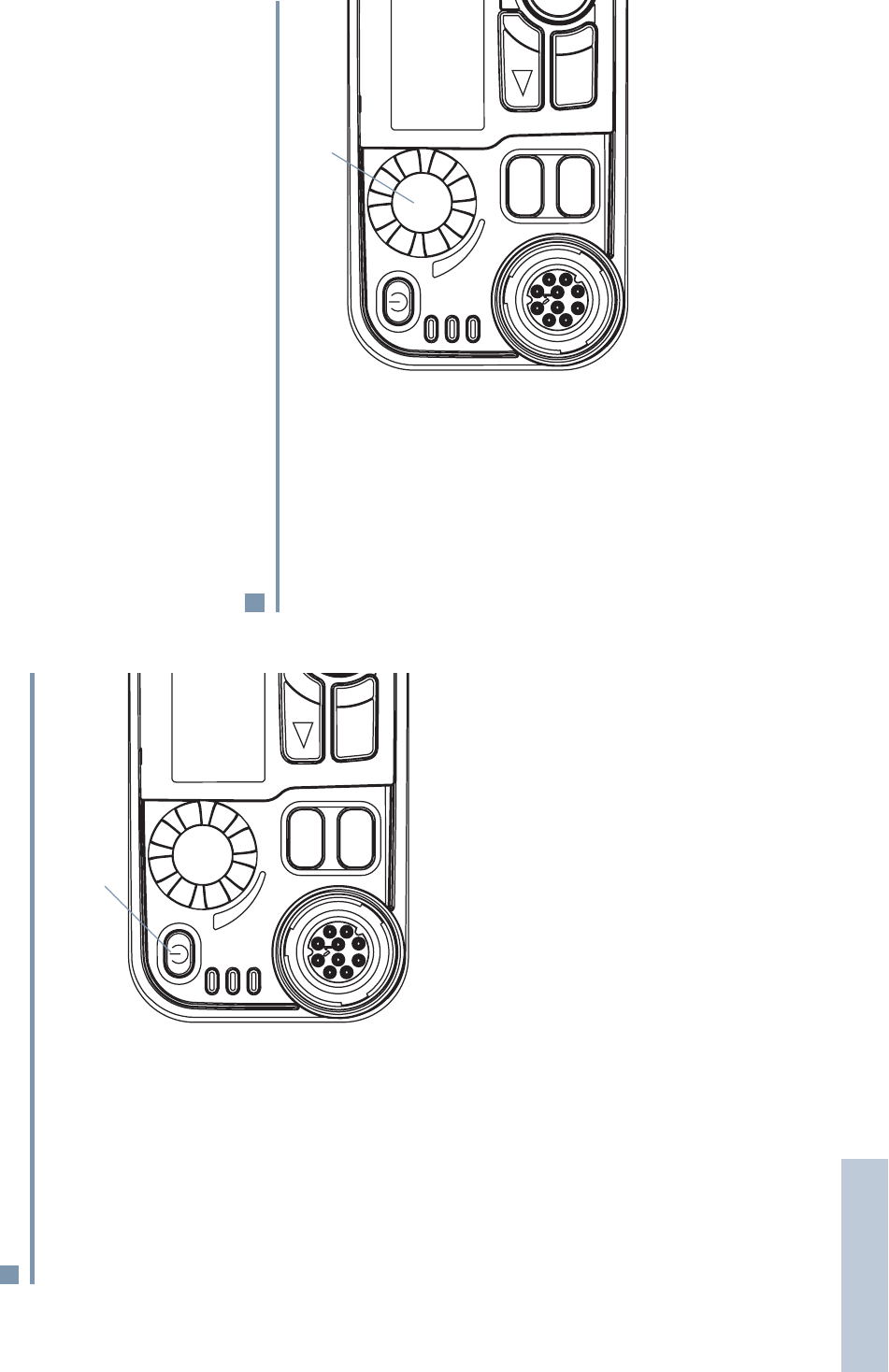
Getting Started
English
2
Powering Up the Radio
Press the On/Off
Button briefly. You see
Motorola and
MOTOTRBO (TM) on the
radio’s display
momentarily, followed
by Motorola once
more.
The green LED blinks
and the Home screen
lights up if the backlight
setting is set to turn on
automatically.
NOTE: The Home screen does not light up during a power up if
the LED indicators are disabled (see Turning the LED
Indicators On or Off on page 37).
A brief tone sounds, indicating that the power up test is
successful.
NOTE: There is no power up tone if the radio tones/alerts
function is disabled (see Turning the Radio Tones/
Alerts On or Off on page 36).
If your radio does not power up, contact your dealer.
To turn off the radio, press and hold the On/Off Button until you
see Powering Down on the radio’s display.
Adjusting the Volume
To increase the
volume, turn the
Volume Knob
clockwise.
To decrease
the volume, turn
this knob
counterclockwise.
P1
P2
MENU
On/Off Button
P1
O
P2
MENU
Volume Knob
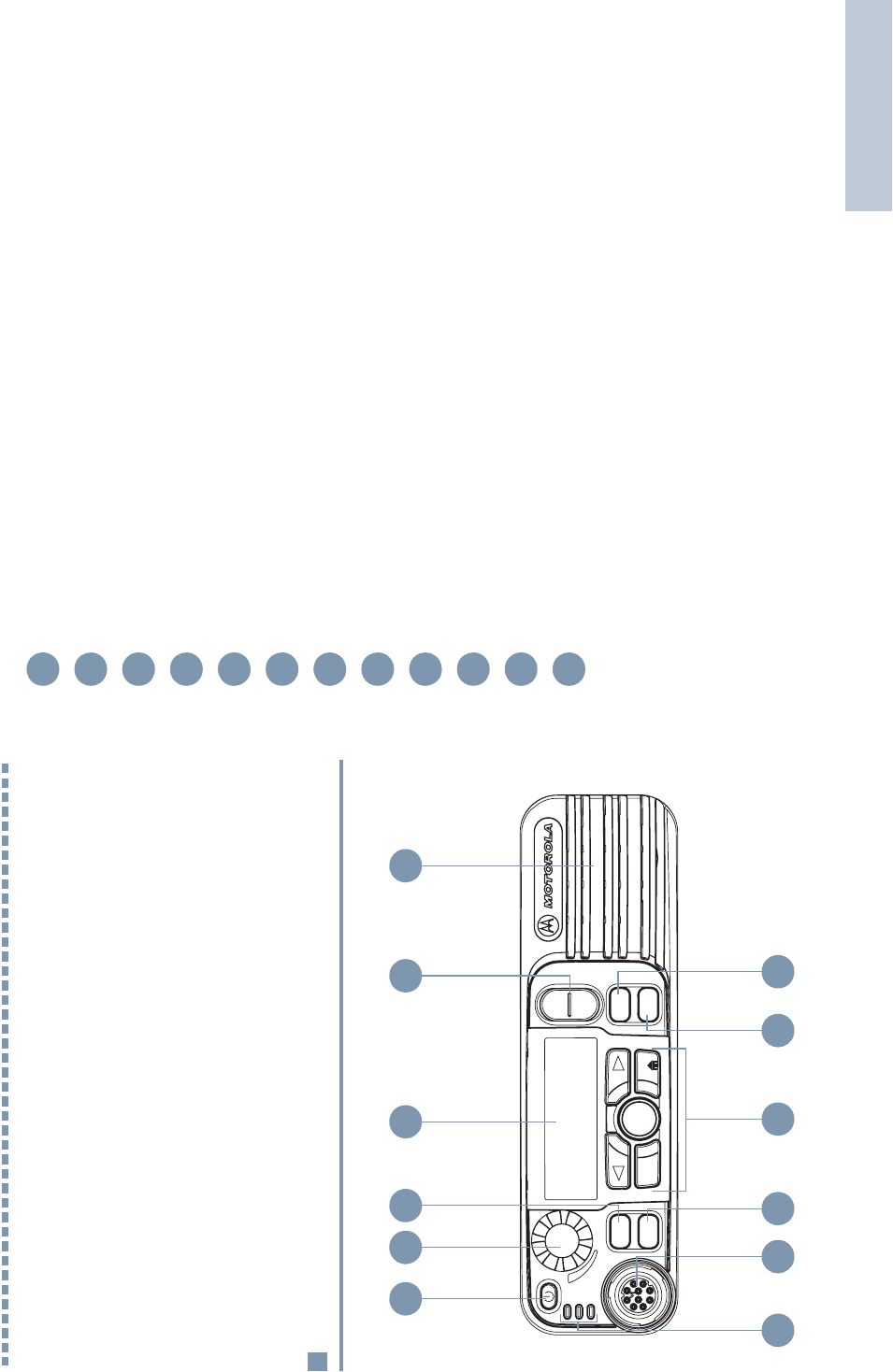
Identifying Radio Controls
English
3
Identifying Radio Controls
Take a moment to review the following:
Radio Controls You Will Be Using . . . . . . . . . . . . . . . . . page 3
Programmable Buttons . . . . . . . . . . . . . . . . . . . . . . . . . page 4
Accessing the Programmed Functions . . . . . . . . . . . . . page 5
Push-To-Talk (PTT) Button . . . . . . . . . . . . . . . . . . . . . . page 6
Switching Between Conventional and Trunking Mode . page 6
Radio Controls You Will Be Using
P1
OK
P2
P3
P4
CH+
BACK
MENU
CH -
12 3 654
12 11 8 7910
On/Off Button
Volume Knob
Front Button P1*
Display
Channel Rocker
Speaker
Front Button P3*
Front Button P4*
Menu Navigation Buttons
Front Button P2*
Accessory Connector
LED Indicators
* These buttons are programmable.
1
2
3
4
5
6
7
8
9
10
11
12

Identifying Radio Controls
English
4
Programmable Buttons
Your dealer can program the programmable buttons as
shortcuts to radio functions or preset channels/groups
depending on the duration of a button press:
•Press –Pressing and releasing rapidly.
•Long press –Pressing and holding for the programmed
duration (between 0.25 seconds and 3.75 seconds).
•Hold down –Keeping the button pressed.
Assignable Radio Functions
Call* –Initiates a private call by keying in or selecting any
subscriber ID and accepts incoming private calls.
Call Alert* –Allows selection of radio ID number to initiate a call
alert.
Contacts –Provides direct access to the Contacts list.
Emergency* –Depending on the programming, initiates or
cancels an emergency alarm or call.
Ext PA On/Off –Toggles the audio routing between the
connected public address (PA) loudspeaker amplifier and the
radio’s internal public address (PA) system.
Hear Clear – Toggles Hear Clear feature on or off.
Message Update* – Selects a message update to send to the
dispatcher.
Monitor** –Monitors a selected channel for activity.
Nuisance Delete –Temporarily removes an unwanted channel
from the scan list until the radio is powered off and on again.
One Touch Call* –Directly initiates a predefined Private Call,
Phone Call, or a Call Alert to a target radio.
PA On/Off –Toggles the radio’s internal public address (PA)
system on or off.
Permanent Monitor** –Monitors a selected channel for all
radio traffic until function is disabled.
Phone –Initiates a phone call by keying in or selecting any
phone ID and accepts incoming phone calls.
Repeater/Talkaround** –Toggles between using a repeater
and communicating directly with another radio.
Scan –Toggles scan on or off.
Site Display* –Displays current site on the radio display.
Site Lock On/Off* – Toggles the automatic site roam on or off
in Smart Zone operation.
Site Search* –Starts site search in Smart Zone operation.
Status Update* –Selects a status update to send to the
dispatcher.
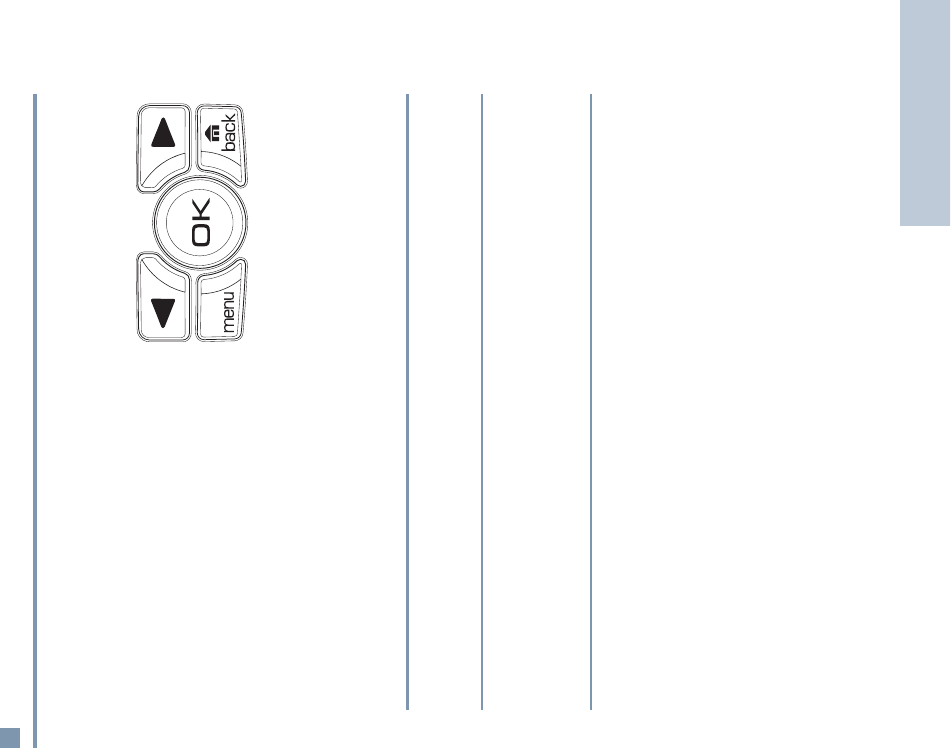
Identifying Radio Controls
English
5
Transmit Inhibit –Prevents transmission when enabled.
Zone –Allows selection from a list of zones.
Assignable Settings/Utility Functions
All Tones/Alerts –Toggles all tones on or off.
Backlight –Controls the display backlight intensity and front
panel buttons backlight intensity.
Horns/Lights –Toggles horns and lights feature on or off.
Power Level –Toggles transmit power level between high and
low.
Squelch** –Toggles squelch level between normal and tight.
* A trunking only feature
** A conventional only feature
Accessing the Programmed Functions
You can access various radio functions through one of the
following ways:
•A short or long press of the
relevant programmable buttons.
OR
•Use the Menu Navigation Buttons as follows:
1To access the menu, press the S button. Press the
appropriate Menu Scroll button (Por Q) to access
the menu functions.
2To select a function or enter a sub-menu, press the N
button.
3To go back one menu level, or to return to the previous
screen, press the R button. Long press the R button
to return to the Home screen.
The Menu Navigation Buttons are also available on a keypad
microphone (see Using the Keypad on page 40).
NOTE: Your radio automatically exits the menu after a period
of inactivity and returns to your Home screen.
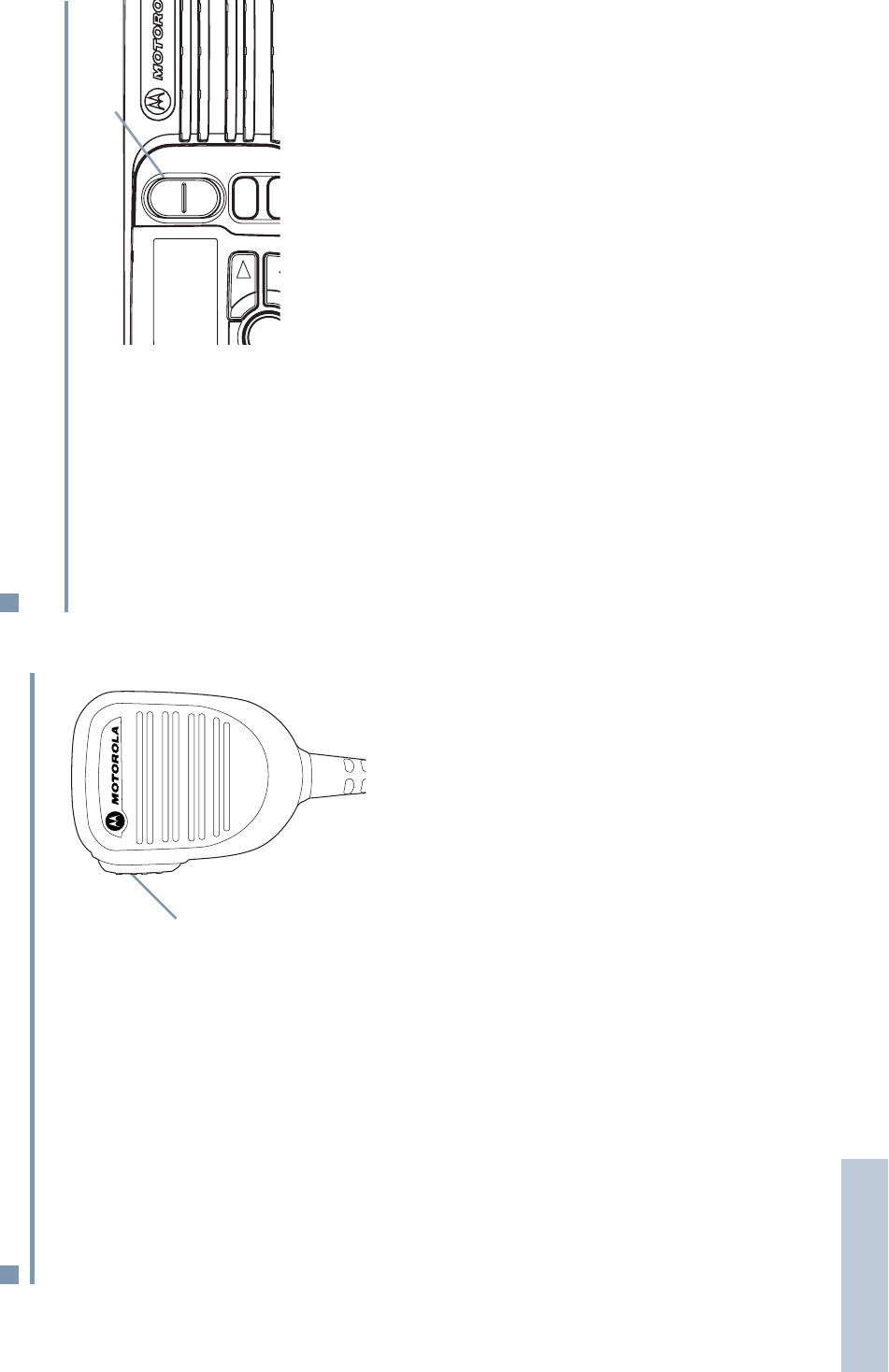
Identifying Radio Controls
English
6
Push-To-Talk (PTT) Button
The PTT button on the side
of the microphone serves
two basic purposes:
•While a call is in
progress, the PTT button
allows the radio to
transmit to other radios in
the call.
Press and hold down PTT
button to talk. Release
the PTT button to listen.
The microphone is activated when the PTT button is pressed.
•While a call is not in progress, the PTT button is used to make
a new call (see Making a Radio Call on page 13).
If the Talk Permit Tone is enabled (see Turning the Talk
Permit Tone On or Off on page 37), wait until the short alert
tone ends before talking.
Switching Between Conventional and
Trunking Mode
Each channel in your
radio can be configured
as a conventional channel
or a trunking channel. Use
the Channel Rocker to
switch between a
conventional or a trunking
channel.
When switching from trunking to conventional mode, certain
features are unavailable. Icons for the trunking features reflect
this change by appearing “grayed out’. Disabled features are
hidden in the menu.
Your radio also has features available in both conventional and
trunking mode. However, the minor differences in the way each
feature works does NOT affect the performance of your radio.
PTT
Button
OK
P3
P4
CH+
BACK
CH -
Channel Rocker
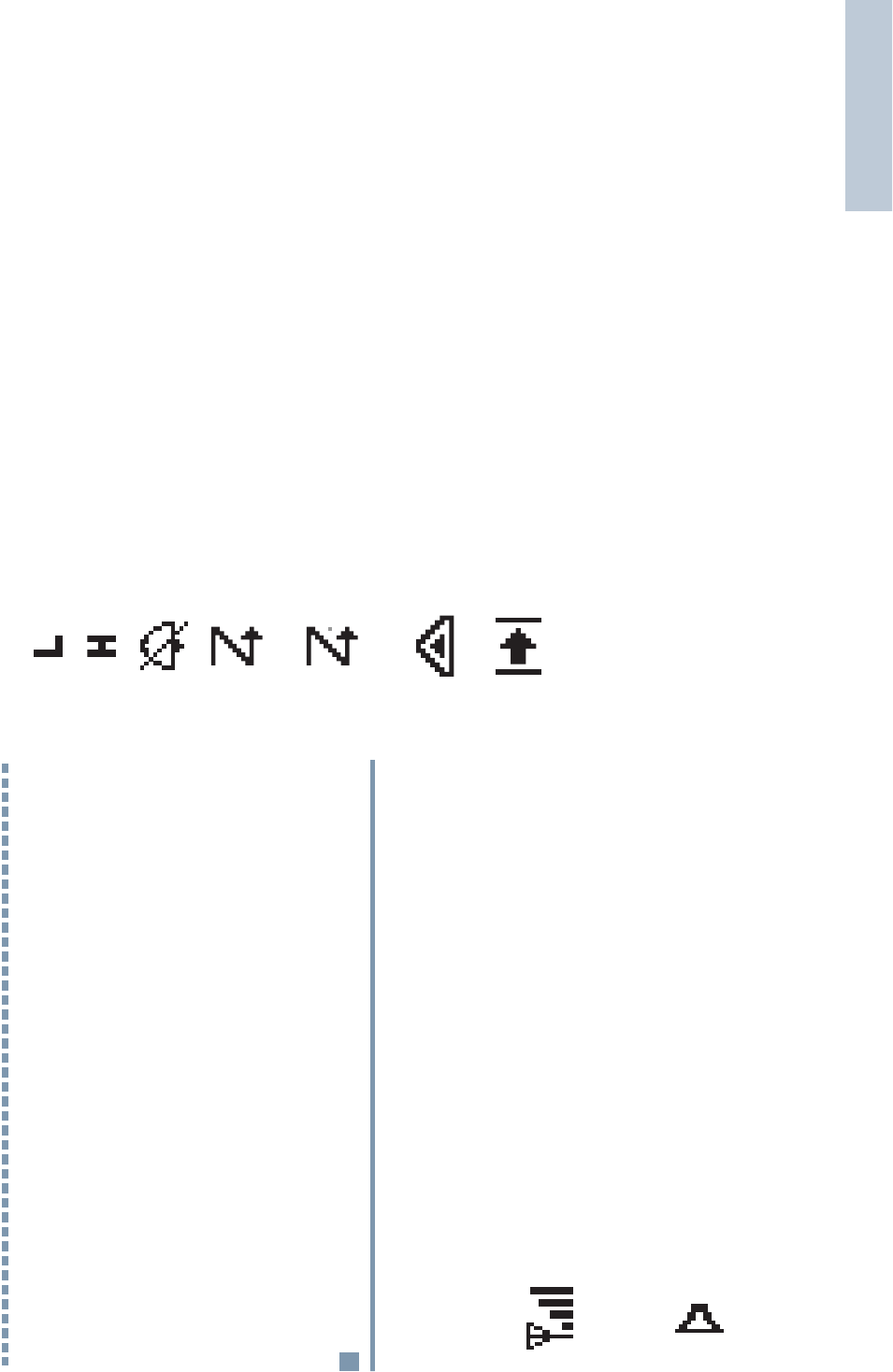
Identifying Status Indicators
English
7
Identifying Status Indicators
Your radio indicates its operational status through the following:
Display Icons . . . . . . . . . . . . . . . . . . . . . . . . . . . . . . . . . page 7
Call Icons. . . . . . . . . . . . . . . . . . . . . . . . . . . . . . . . . . . . page 8
Main Menu Icons . . . . . . . . . . . . . . . . . . . . . . . . . . . . . . page 8
In-Menu Icons . . . . . . . . . . . . . . . . . . . . . . . . . . . . . . . . page 8
LED Indicators. . . . . . . . . . . . . . . . . . . . . . . . . . . . . . . . page 9
Audio Tones. . . . . . . . . . . . . . . . . . . . . . . . . . . . . . . . . . page 9
Display Icons
The liquid crystal display (LCD) of your radio shows the radio
status, text entries, and menu entries.
The following are the icons that appear on the radio’s display.
Received Signal Strength Indicator (RSSI)
NOTE: This is a trunking only feature.
The number of bars displayed represents the radio
signal strength. Four bars indicates the strongest
signal. This icon is only displayed while receiving.
Monitor
NOTE: This is a conventional only feature.
Selected channel is being monitored.
Power Level
Radio is set at Low power.
Radio is set at High power.
Tones Disable
Tones are turned off.
Scan
Scan feature is activated.
Priority Scan
Radio detects activity on channel/group designated
as Priority 1 (if • is blinking) or Priority 2 (if • is
steady).
Emergency
Radio is in Emergency mode.
Talkaround
In the absence of a repeater, radio is currently
configured for direct radio to radio communication.
or
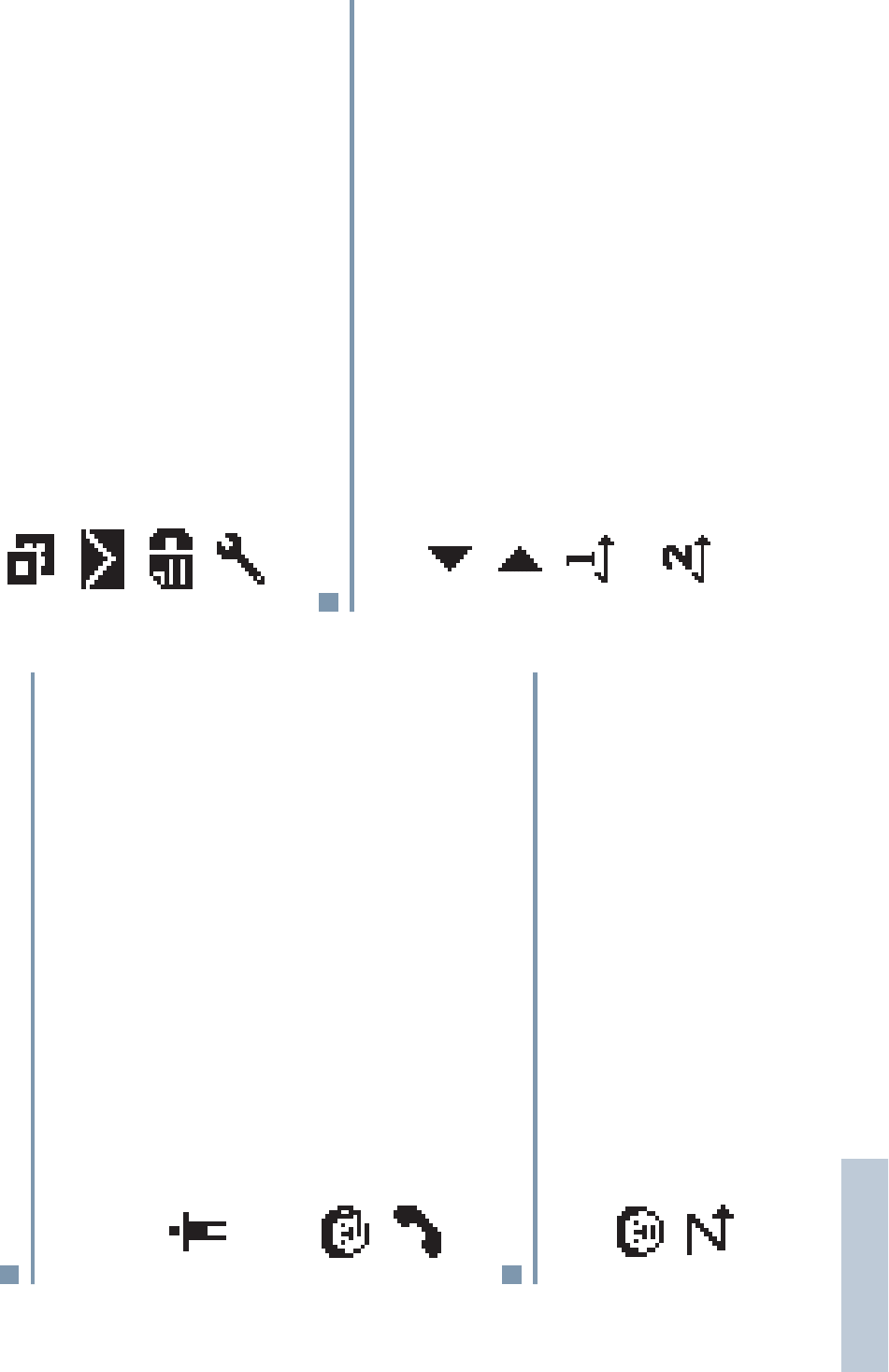
Identifying Status Indicators
English
8
Call Icons
The following icons appear on the radio’s display during a call.
These icons also appear in the Contacts list to indicate alias or
ID type.
Main Menu Icons
The following are icons that appear on the radio’s display.
In-Menu Icons
The following are icons that appear on the radio’s display.
Private Call
NOTE: This is a trunking only feature.
Indicates a Private Call in progress. In the Contacts
list, it indicates a subscriber alias (name) or ID
(number).
Dispatcher Call
Indicates a Dispatcher Call Type in progress.
Phone Call
Indicates a Phone Call Type in progress.
Contacts
Selects the Contacts menu.
Scan
Selects the Scan menu.
Zone
Allows selection from a list of zones.
TMS
Selects the Status and Message menu.
Call Log
Selects the Call Log menu.
Utilities
Selects the Utilities menu.
Left Arrow
Navigates to the left of the items in the display.
Right Arrow
Navigates to the right of the items in the display.
Scan Priority 1
Detects activity on channel/group designated as
Priority 1.
Scan Priority 2
Detects activity on channel/group designated as
Priority 2.
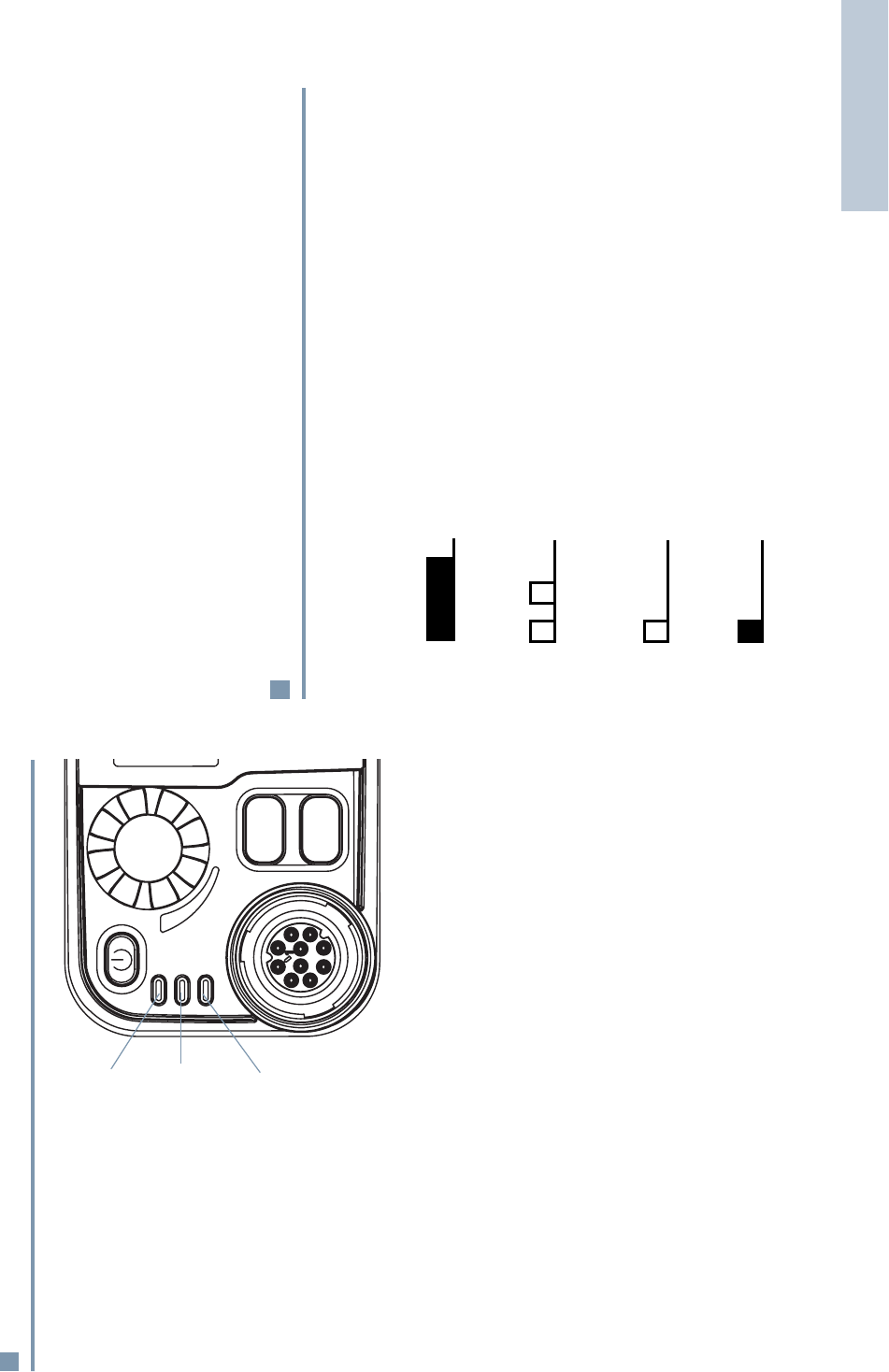
Identifying Status Indicators
English
9
LED Indicators
LED indicators show
the operational status
of your radio.
Blinking red –Radio is
receiving an
Emergency
transmission or has
failed the self-test upon
powering up.
Solid yellow –Radio is
in Permanent Monitor
mode, monitoring a
channel, or requested trunked call has no voice channel or
target is busy.
Blinking yellow – Radio is scanning for activity or receiving a
Call Alert.
Solid green –Radio is transmitting.
Blinking green –Radio is powering up, receiving a non-
privacy-enabled call or data, or detecting activity over the air.
NOTE: When the green LED blinks, it indicates the radio
detects activity over the air. Due to the nature of the
digital protocol, this activity may or may not affect the
radio's programmed channel.
Upon a PTT button press, if the radio is programmed
for polite operation, the radio automatically determines
whether a transmission is permitted via a Talk Permit
or a Talk Denial tone.
Audio Tones
Alert tones provide you with audible indications of the radio’s
status or the radio’s response to data received.
P1
P2
Red
Yellow
Green
Continuous Tone A monotone sound. Sounds
continuously until termination.
Periodic Tone Sounds periodically depending on the
duration set by the radio. Tone starts,
stops, and repeats itself.
Repetitive Tone A single tone that repeats itself until it is
terminated by the user.
Momentary Tone Sounds only once for a short period of
time defined by the radio.

Receiving and Making Calls
English
10
Receiving and Making Calls
Once you understand how your MOTOTRBO Mobile is
configured, you are ready to use your radio.
Use this navigation guide to familiarize yourself with the basic
Call features:
Selecting a Zone . . . . . . . . . . . . . . . . . . . . . . . . . . . . . page 10
Selecting a Radio Channel . . . . . . . . . . . . . . . . . . . . . page 11
Receiving and Responding to a Radio Call. . . . . . . . . page 11
Making a Radio Call . . . . . . . . . . . . . . . . . . . . . . . . . . page 13
Talkaround . . . . . . . . . . . . . . . . . . . . . . . . . . . . . . . . . page 17
Permanent Monitor . . . . . . . . . . . . . . . . . . . . . . . . . . . page 18
Selecting a Zone
A zone is a group of channels. Your radio supports up to 130
zones, with a maximum of 240 channels per zone.
Use the following procedure to select a zone.
Procedure:
Press the programmed Zone button and proceed to step 3.
OR
Follow the procedure below.
1S to access the menu.
2Por Q to Zone and press N to select.
3The current zone is displayed and indicated by a 9.
4Por Q to the required zone and press N to select.
5The display shows <Zone> Selected momentarily and
returns to the selected zone screen.
NOTE: The zones appear in alphabetical order, if named.
The Zone main menu option will not appear, if the radio
is not configured for zones.

Receiving and Making Calls
English
11
Selecting a Radio Channel
Procedure:
Once the required
zone is displayed (if
you have multiple
zones in your radio),
press the Channel
Rocker to select the
channel, subscriber
alias or ID, or group
alias or ID.
Receiving and Responding to a Radio Call
NOTE: This is a trunking only feature.
Once you have selected the
required channel and/or zone,
you can proceed to receive
and respond to calls.
The green LED lights up
while the radio is transmitting
and blinks when the radio is
receiving.
Receiving and Responding to a Group Call
To receive a call from a group of users, your radio must be
configured as part of that group.
Procedure:
When you receive a Group Call (while on the Home screen):
1The green LED blinks.
2The first line of the display shows the alias or ID of the
caller, and the RSSI icon. The second line displays the
related personality alias.
3Press the PTT button to respond to the call. The green LED
lights up.
4Wait for the Talk Permit Tone to finish (if enabled) and
speak clearly into the microphone.
5Release the PTT button to listen.
6If there is no voice activity for a predetermined period of
time, the call ends.
See Making a Group Call on page 14 for details on making a
Group Call.
OK
P3
P4
CH+
BACK
CH -
Channel Rocker
P1
Green
LED

Receiving and Making Calls
English
12
NOTE: If the radio receives a Group Call while not on the
Home screen, it remains on its current screen prior to
answering the call.
Long press the R button to go to Home screen to
view the caller alias before replying.
Receiving and Responding to a Private Call
A Private Call is a call from an individual radio to another
individual radio.
There are two types of Private Calls. The first type is called
Enhanced Private Call, where a radio presence check is
performed prior to setting up the call, while the other, Basic
Private Call, sets up the call immediately.
Procedure:
When you receive a Private Call:
1A tone sounds and the green LED blinks.
2The first line of the display shows the subscriber alias or ID,
and the Private Call and RSSI icons. The second line
displays Response.
3Press Nto select Response.
OR
Press the Call button before the call indicators end.
4The first line of the display shows the subscriber alias or ID,
and the Private Call and RSSI icons. The second line
displays Private Call.
5Press and hold the PTT button to respond.
6The first line of the display shows Calling. The second line
displays the subscriber alias or ID, and the Private Call icon.
7When you are connected, the first line of the display shows
the subscriber alias or ID, and the Private Call and RSSI
icons. The second line displays Private Call.
8 Release the PTT button to listen.
See Making a Private Call on page 14 for details on making a
Private Call.

Receiving and Making Calls
English
13
Receiving and Responding to a Phone Call
A Phone Call is a call similar to a standard phone call from a
landline phone.
Procedure:
When you receive a Phone Call:
1A tone sounds and the green LED blinks.
2The first line of the display shows Phone Call and the RSSI
icon. The second line displays Response.
3Press N to select Response.
4The first line of the display shows Phone Call. The second
line displays Responding.
5Press and hold the PTT button to talk. Release the PTT
button to listen.
See Making a Phone Call on page 15 for details on making a
Phone Call.
Making a Radio Call
You can select a zone, channel, subscriber alias or ID, or group
alias or ID by using:
•The Channel Rocker
•A programmed One Touch Call button*
•The Contacts list (see Contacts Settings on page 23)*
•Manual Dial (via Call/Phone/Call Alert button) –This method
is for Private Call, Phone Call or Call Alert, and is dialed using
a keypad microphone (see Making a Private Call from
Contacts on page 23 or Making a Phone Call on page 15)*
* A trunking only feature

Receiving and Making Calls
English
14
Making a Call with the Channel Rocker
NOTE: This is a trunking only feature.
Making a Group Call
To make a call to a group of users, your radio must be
configured as part of that group.
Procedure:
1Press the Channel Rocker to select the channel with the
targeted talkgroup.
2Press the PTT button to make the call. The green LED lights
up.
3Wait for the Talk Permit Tone to finish (if enabled) and
speak clearly into the microphone.
4Release the PTT button to listen.
Making a Private Call
Procedure:
Press the programmed Quick Access (One-Touch) Private
Call button to dial the programmed ID (number) and proceed to
Step 4.
OR
1Press the Call button to call.
2The display shows the call list, you can scroll through and
select the required ID (any target ID or last transmitted or
received ID) or go to the manual dial option to enter the
required ID.
3Press the PTT button to start the Private Call. The green
LED lights up.
4The first line of the display shows Calling. The second line
displays the target alias or ID and the Private Call icon.
5When you are connected, the first line of the display shows
the ID or alias of the target radio and the Private Call icon.
The second line displays Private Call. Press and hold the
PTT button to talk. Release the PTT button to listen.
OR
If no acknowledgment is received, the display shows No
Answer.

Receiving and Making Calls
English
15
You can also make a Private Call via Contacts (see Making a
Private Call from Contacts on page 23) or perform a quick
alphanumeric search for the required target alias via a keypad
entry (see Making a Private Call by Alias Search on page 41).
Making an Enhanced Private Call
This feature allows you to send an individual Call Alert page if
there is no answer from the target radio.
NOTE: Your radio must be programmed to allow you to use
this feature.
Procedure:
Press the programmed Quick Access (One-Touch) Private
Call button to dial the programmed ID (number) and proceed to
Step 4.
OR
1Press the Call button to call.
2The display shows the call list, you can scroll through and
select the required ID (any target ID or last transmitted or
received ID) or go to the manual dial option to enter the
required ID.
3Press the PTT button to initiate the Private Call request.
4The first line of the display shows Calling. The second line
displays the target alias or ID and the Private Call icon.
5When you are connected, the first line of the display shows
the ID or alias of the target radio and Private Call icon. The
second line displays Private Call. You may hear the
Private Call voice if the target is talking.
6Press and hold the PTT button to talk. Release the PTT
button to listen.
OR
If no acknowledgment is received, the display shows No
Answer.
Making a Phone Call
This feature allows you to make calls similar to standard phone
calls to a mobile or landline phone. Your radio must be
programmed to allow you to use Delayed Access Buffered
Dialing method for below procedure.
Procedure:
Press the programmed Quick Access (One-Touch) Private
Call button to dial the programmed phone number and proceed
to Step 4.
OR
Follow the procedure below.
1Press Phone button.

Receiving and Making Calls
English
16
2The display shows the phone list, you can scroll through and
select the required ID (any target ID or last transmitted or
received ID) or go to the manual dial option to enter the
required ID.
3Press the PTT button to initiate the Phone Call request. The
green LED lights up.
4The first line of the display shows Calling. The second line
displays the target alias or ID and the Phone Call icon. The
dial tone will be heard, then DTMF tone sounded for phone
ID Transmission.
5After phone number transmission, the first line of the display
shows the phone alias or number and the Phone Call icon,
the second line displays Phone Call, and you may hear the
voice from the telephone user.
6Press the PTT button to talk. Release the PTT button to
listen.
Sending a Status Call
This feature allows you to send data calls to the dispatcher
about a predefined status.
Each status can have up to a 14-character name. A maximum
of eight status conditions is possible.
NOTE: The radio automatically exits the feature, if the time-out
timer is enabled, when the radio is left idle and the
timer expires. You will hear the Menu Inactive Exit
Tone upon feature exit.
Procedure:
Press the programmed Status button and proceed to Step 3.
OR
Follow the procedure below.
1PorQ to Status and press N to select.
2The display shows the last acknowledged status call, or the
first status in the list.
3PorQ to the required status.
OR
If you are using a keypad microphone, enter a number
corresponding to the location in the status list.
4Press Nto send the status.
5When the dispatcher acknowledges, four tones sound and
the display shows Ack Received. The radio returns to
normal dispatch operation.
OR
If no acknowledgment is received, a low-pitched tone
sounds and the display shows No Acknowledge.

Receiving and Making Calls
English
17
No traffic is heard on trunked channels while Status Calls is
selected. If the radio detects no Status Call activity for six
seconds, an alert tone sounds until you press Home or the PTT
button.
Using the Dynamic Regrouping Feature
This feature allows the dispatcher to temporarily reassign
selected radios to a single special channel so they can
communicate with each other. This feature is typically used
during special operations and is enabled by a qualified radio
technician.
You will not notice whether your radio has this feature enabled
until a dynamic regrouping command is sent by the dispatcher.
NOTE: If you try to access a zone or channel that has been
reserved by the dispatcher as a dynamically regrouped
mode for other users, an invalid tone sounds.
Procedure:
1When your radio is dynamically regrouped, it automatically
switches to the dynamically regrouped channel. A “gurgle”
tone sounds and the display shows the dynamically
regrouped channel name.
2Press the PTT button to talk. Release PTT button to listen.
When the dispatcher cancels dynamic regrouping, the radio
automatically returns to the zone and channel that you were
using before the radio was dynamically regrouped.
Talkaround
NOTE: This is a conventional only feature.
You can continue to communicate when your repeater is not
operating, or when your radio is out of the repeater’s range but
within talking range of other radios. This is called “talkaround”.
Procedure:
Press the programmed Repeater/Talkaround button to toggle
between talkaround and repeater modes.
OR
Follow the procedure below.
1S to access the menu.
2Por Q to Utilities and press N to select.
3Por Q to Radio Settings and press N to select.
4Por Q to Talkaround and press N to select.

Receiving and Making Calls
English
18
5You see Turn On if the radio is currently in Repeater mode.
OR
You see Turn Off if the radio is currently in Talkaround
mode.
6Press N to select.
7The display shows Talkaround On.
OR
The display shows Talkaround Off.
8The screen automatically returns to the previous menu.
The Talkaround setting is retained even after powering down.
Permanent Monitor
Use the Permanent Monitor feature to continuously monitor a
selected channel for activity.
Procedure:
1Press the programmed Permanent Monitor button.
2Radio sounds an alert tone, the yellow LED lights up, and
the display shows Permanent Monitor On. The monitor
icon appears on the display.
3Press the programmed Permanent Monitor button to exit
Permanent Monitor mode.
4Radio sounds an alert tone, the yellow LED turns off, and
display shows Permanent Monitor Off.

Advanced Features
English
19
Advanced Features
Use this navigation guide to learn more about advanced
features available with your radio:
Scan Lists . . . . . . . . . . . . . . . . . . . . . . . . . . . . . . . . . . page 19
Scan . . . . . . . . . . . . . . . . . . . . . . . . . . . . . . . . . . . . . . page 21
Contacts Settings . . . . . . . . . . . . . . . . . . . . . . . . . . . . page 23
Call Indicator Settings . . . . . . . . . . . . . . . . . . . . . . . . . page 24
Call Log Features . . . . . . . . . . . . . . . . . . . . . . . . . . . . page 25
Call Alert Operation . . . . . . . . . . . . . . . . . . . . . . . . . . . page 25
Emergency Operation . . . . . . . . . . . . . . . . . . . . . . . . . page 27
Trunking System Controls . . . . . . . . . . . . . . . . . . . . . . page 32
Utilities. . . . . . . . . . . . . . . . . . . . . . . . . . . . . . . . . . . . . page 34
Scan Lists
Scan lists are created and assigned to individual channels/
groups. Your radio scans for voice activity by cycling through
the channel/group sequence specified in the scan list for the
current channel/group.
Your radio can support up to 128 scan lists, with a maximum of
16 members in a list. You can add, delete, or prioritize channels
by editing a scan list.
NOTE: Priority scan is only available in trunking mode.
Viewing an Entry in the Scan List
Procedure:
1S to access the menu.
2Por Q to Scan and press N to select.
3Por Q to View/Edit List and press N to select.
4Use Por Q to view each member on the list.
The priority icon appears left of the member’s alias, if set, to
indicate whether the member is on a Priority 1 or Priority 2
channel list. You cannot have multiple Priority 1 or Priority 2
channels in a scan list.
There is no priority icon if priority is set to None.
Editing the Scan List
Adding a New Entry to the Scan List
Procedure:
1S to access the menu.
2Por Q to Scan and press N to select.
3Por Q to View/Edit List and press N to select.
4Por Q to Add Member and press N to select.

Advanced Features
English
20
5Por Q to the required alias or ID and press N to
select.
6Por Q to the required priority level and press N to
select.
7The display shows Entry Saved, followed immediately by
Add Another?.
8Por Q to Yes and press N to select, to add another
entry, and repeat steps 5 and 6.
OR
Por Q to No and press N to select to save the current
list.
Deleting an Entry from the Scan List
Procedure:
1S to access the menu.
2Por Q to Scan and press N to select.
3Por Q to View/Edit List and press N to select.
4Por Q to the required alias or ID and press N to
select.
5Por Q to Delete and press N to select.
6At Delete Entry?,Por Q to Yes and press N to
select, to delete the entry. The display shows Entry
Deleted.
OR
Por Q to No and press N to select to return to the
previous screen.
7Repeat steps 4 to 6 to delete other entries.
After deleting all required aliases or IDs, long press R to
return to the Home screen.
Setting and Editing Priority for an Entry in the Scan
List
Procedure:
1S to access the menu.
2Por Q to Scan and press N to select.
3Por Q to View/Edit List and press N to select.
4Por Q to the required alias or ID and press N to
select.
5Por Q to Edit Priority and press N to select.
6Por Q to the required priority level and press N to
select.

Advanced Features
English
21
7The display shows Entry Saved before returning to the
previous screen.
8The priority icon appears left of the member’s name.
There is no priority icon if priority is set to None.
Scan
When you start a scan, your radio cycles through the
programmed scan list for the current channel looking for voice
activity.
The yellow LED blinks and you see the scan icon on the display.
There are two ways of initiating scan:
•Main Channel Scan (Manual): Your radio scans all the
channels/groups in your scan list. On entering scan, your
radio may – depending on the settings – automatically start
on the last scanned “active” channel/group or on the channel
where scan was initiated.
•Auto Scan (Automatic): Your radio automatically starts
scanning when you select a channel/group that has Auto
Scan enabled.
Starting and Stopping Scan
Procedure:
Press the programmed Scan button to start or stop Scan.
OR
Follow the procedure below.
1Use the Channel Rocker to select a channel programmed
with a scan list.
2S to access the menu.
3Por Q to Scan and press N to select.
4The display shows Turn On if scan is disabled.
OR
The display shows Turn Off if scan is enabled.
5Press N to select.
6The yellow LED blinks and the scan icon is displayed when
Scan is enabled.
OR
The LED turns off and the scan icon is not displayed when
Scan is disabled.

Advanced Features
English
22
Responding to a Transmission During a Scan
During scanning, your radio stops on a channel/group where
activity is detected. The radio stays on that channel for a
programmed time period known as “hang time”.
Procedure:
1Press the PTT button during hang time. The green LED
lights up.
2Wait for the Talk Permit Tone to finish (if enabled) and
speak clearly into the microphone.
3Release the PTT button to listen.
4If you do not respond within the hang time, the radio returns
to scanning other channels/groups.
Deleting a Nuisance Channel
If a channel continually generates unwanted calls or noise
(termed a “nuisance” channel), you can temporarily remove the
unwanted channel from the scan list.
This capability does not apply to the channel designated as the
Selected Channel.
Procedure:
1When your radio “locks on to” an unwanted or nuisance
channel, press the programmed Nuisance Delete button
until you hear a tone.
2Release the Nuisance Delete button. The nuisance
channel is deleted.
Deleting a “nuisance” channel is only possible through the
programmed Nuisance Delete button. This feature is not
accessible through the menu.
Restoring a Nuisance Channel
Procedure:
To restore the deleted nuisance channel, do ONE of the
following:
•Turn the radio off and then powering it on again, OR
•Stop and restart a scan via the programmed Scan button or
menu, OR
•Change the channel via the Channel Rocker.

Advanced Features
English
23
Contacts Settings
Contacts provides “address-book” capabilities on your radio.
Each entry corresponds to an alias or ID that you use to initiate
a call.
Additionally, each entry, depending on context, associates with
ONE of four types of calls: Phone Call, Private Call, Selective
Call or Call Alert.
PC Call and Dispatch Call are data-related. They are only
available with the applications. Refer to the data applications
documentation for further details.
Your radio supports one Contacts list, Analog contacts (with a
maximum of 250 members for Radio Call entry and a maximum
of 50 members for Phone Call entry).
Each entry within Contacts displays the following information:
•Call Type
•Call Alias
•Call ID
NOTE: You can add, delete, or edit subscriber aliases or IDs
for the Analog Contacts list.
Making a Private Call from Contacts
Procedure:
1S to access the menu.
2Por Q to Contacts and press N to select.The
entries are alphabetically sorted.
3Por Q to the required subscriber alias or ID.
4Press the PTT button to start the Private Call. The first line
displays Calling. The second line displays the target alias
or ID and the Private Call icon.
5When you are connected, the display shows the ID or alias
of the target radio and the Private Call icon. Private Call
is displayed on second line. Talk Permit Tone will be heard if
enabled.
6Press and hold the PTT button to talk.
7Release the PTT button to listen.

Advanced Features
English
24
Call Indicator Settings
Activating and Deactivating Call Ringers for
Private Calls
NOTE: This is a trunking only feature.
You can turn on or off the ringing tones for a received Private
Call.
Procedure:
1S to access the menu.
2Por Q to Utilities and press N to select.
3Por Q to Radio Settings and press N to select.
4Por Q to Tones/Alerts and press N to select.
5Por Q to Call Ringers and press N to select.
6Por Q to Private Call and press N to select.
7The display shows Turn On. Press N to enable Call
Ringers for Private Calls. The display shows Private Call
Ringer On.
OR
The display shows Turn Off. Press N to disable Call
Ringers for Private Calls. The display shows Private Call
Ringer Off.
NOTE: To activate or deactivate call ringer for Selective Call/
Call Alert/Phone Call, follow similar steps as above.
Escalating Alarm Tone Volume
You can program your radio to continually alert you when a
radio call remains unanswered. This is done by automatically
increasing the alarm tone volume over time. This feature is
known as Escalert.
Procedure:
1S to access the menu.
2Por Q to Utilities and press N to select.
3Por Q to Radio Settings and press N to select.
4Por Q to Tones/Alerts and press N to select.
5Por Q to Escalert and press N to select.
6The display shows Turn On. Press N to enable Escalert.
The display shows Escalert On.
OR
The display shows Turn Off. Press N to disable Escalert.
The display shows Escalert Off.

Advanced Features
English
25
Call Log Features
NOTE: This is a trunking only feature.
Your radio keeps track of all recent incoming and outgoing
Radio Calls, and outgoing Phone Calls. Use the call log feature
to view and manage recent calls.
You can perform the following tasks in each of your call lists:
•Store alias or ID to Contacts
•Delete
Viewing Recent Calls
The lists are Radio Rcvd,Radio Dialed, and Phone Dialed.
Procedure:
1S to access the menu.
2Por Q to Call Log and press N to select.
3Por Q to preferred list and press N to select.
4The display shows the most recent entry at the top of the
list.
5Por Q to view the list.
Deleting a Call from a Call List
Procedure:
1S to access the menu.
2Por Q to Call Log and press N to select.
3Por Q to the required list and press N to select.
4Por Q to the required alias or ID and press N to
select.
5Por Q to Delete Entry? and press N to select.
6Por Q to Yes and press N to select.
7The display shows Entry Deleted.
When you select a call list and it contains no entries, the display
shows List Empty, and sounds a low tone if Keypad Tones are
turned on (see Turning Keypad Tones On or Off on page 41).
Call Alert Operation
NOTE: This is a trunking only feature.
Call Alert paging enables you to alert a specific radio user to call
you back when they are able to do so.
This feature is applicable for subscriber aliases or IDs only and
is accessible through the menu via Contacts or manual dial.

Advanced Features
English
26
Receiving and Acknowledging a Call Alert
When you receive a Call Alert page, you see Call Alert that
alternates with the alias or ID of the calling radio on the display.
Procedure:
1You hear a repetitive tone. The yellow LED blinks.
2Press and release the PTT button to acknowledge the alert.
OR
Press N to exit the Call Alert.
Making a Call Alert from the Contacts List
Procedure:
1S to access the menu.
2Por Q to Contacts and press N to select.
3Por Q to the required subscriber alias or ID and press
N to select.
4Por Q to Call Alert and press N to select.
5The display shows Call Alert: <Subscriber Alias or
ID>, indicating that the Call Alert has been sent.
6The green LED lights up when your radio is sending the Call
Alert.
7If the Call Alert acknowledgment is received, a tone sounds
and the display shows Call Alert Successful.
OR
If the Call Alert acknowledgment is not received, a tone
sounds and the display shows Call Alert Failed.
Making a Call Alert with the One Touch Call Button
Procedure:
1Press the programmed One Touch Call button to make a
Call Alert to the predefined alias or ID.
2The display shows Call Alert: <Subscriber Alias or
ID>, indicating that the Call Alert has been sent.
3The green LED lights up when your radio is sending the Call
Alert.
4If the Call Alert acknowledgment is received, a tone sounds
and the display shows Call Alert Successful.
OR
If the Call Alert acknowledgment is not received, a tone
sounds and the display shows Call Alert Failed.

Advanced Features
English
27
Emergency Operation
NOTE: This is a trunking only feature.
The Emergency feature is used to indicate a critical situation.
You are able to initiate an Emergency at any time on any screen
display even when there is activity on the current channel.
Your radio supports the following Emergency modes:
•Emergency Call
•Emergency Alarm
•Emergency Alarm with Call
•Emergency Alarm with Voice to Follow
In addition, each mode has the following types:
•Regular –Radio transmits an alarm signal and shows audio
and/or visual indicators.
•Silent –Radio transmits an alarm signal without any audio or
visual indicators. There will be no response (call) from the
target radio until you press the PTT button to initiate the call.
•Silent with Voice – Radio transmits an alarm signal and is
able to receive an incoming call, without any audio or visual
indicators, until you press the PTT button to initiate, or
respond to, the call.
Only ONE of the Emergency modes above can be assigned to
the programmed Emergency button or the Emergency
footswitch.
Receiving an Emergency Call
Procedure:
1When receiving an Emergency Call, the first line of the
display shows the alias or ID of the caller. The second line
displays Emergency.
2The red LED blinks and you hear a voice from the
Emergency Call.
3If the voice channel is lost, the Emergency Call ends.
Receiving an Emergency Alarm
Procedure:
1When receiving an Emergency Alarm, the first line of the
display shows the alias or ID of the sender. The second line
displays Alarm Rcvd.
2A tone sounds and the red LED blinks.
3Press any button (except for backlight and volume) to clear
the alarm indication.
OR
If no button is pressed, the alarm indication exits
automatically after a short duration.

Advanced Features
English
28
When your radio receives an Emergency Alarm, it displays the
Emergency Alarm received indications for approximately, 10
seconds.
Receiving an Emergency Alarm with Call
Procedure:
1When receiving an Emergency Alarm with Call, the first line
of the display shows the alias or ID of the sender. The
second line displays Alarm Rcvd.
2A tone sounds and the red LED blinks.
3Press any button (except for backlight and volume) to clear
the alarm indication.
OR
If no button is pressed, the alarm indication exits
automatically after a short duration.
4You hear a voice from the Emergency Alarm with Call.
5Press PTT button to initiate a call with the emergency
initiating radio. The green LED lights up.
6Wait for the Talk Permit Tone to finish (if enabled) and
speak clearly into the microphone.
7Release the PTT button to listen. When the emergency
initiating radio responds, the green LED blinks.
Sending an Emergency Call
This feature gives your radio priority access on a channel.
NOTE: The radio operates in the normal dispatch manner
while in Emergency Call, except, if enabled, it returns
to one of the following:
•Tactical/Non-Revert – You talk on the channel you
selected before you entered the emergency state.
•Non-Tactical/Revert – You talk on a programmed
emergency channel. The emergency alarm is sent
on this same channel.
Procedure:
1Press the programmed Emergency button or the
Emergency footswitch.
2The display shows Emergency, which alternates with your
radio ID. The green LED lights up and the Emergency icon
appears on the Home screen display.
OR
The display shows No Emergency, if the selected channel
does not support emergency. Select a channel that shows
Emergency.
3Press and hold the PTT button. Speak clearly into the
microphone.
4Release the PTT button to end the transmission and wait for
a response from the dispatcher.

Advanced Features
English
29
5Press and hold the programmed Emergency button for
about a second to exit the Emergency Call mode.
If your radio is set to Silent, it will not have any audio or visual
indicators related to the Emergency feature.
Sending an Emergency Alarm
This feature allows you to send an Emergency Alarm, a non-
voice signal, which triggers an alert indication on another radio.
Procedure:
1Press the programmed Emergency button or the
Emergency footswitch.
2The display shows Sending Alarm, which alternates with
your radio ID. The green LED lights up and the Emergency
icon appears on the Home screen display. An Emergency
Enter Tone sounds upon each retry.
3When an Emergency Alarm acknowledgment is received,
the Emergency Acknowledgment Tone sounds and the
green LED blinks. The display shows Emergency Alarm
Successful.
OR
If your radio does not receive an Emergency Alarm
acknowledgment, and after all retries have been exhausted,
a tone sounds and the display shows Emergency Alarm
Failed.
4Radio exits the Emergency Alarm mode and returns to the
Home screen.
If your radio is set to Silent, it will not have any audio or visual
indicators related to the Emergency feature.
Sending an Emergency Alarm with Call
This feature allows you to send an Emergency Alarm to another
radio. Upon acknowledgment, both radios can communicate
over a programmed Emergency channel.
Procedure:
1Press the programmed Emergency button or the
Emergency footswitch.
2The display shows Sending Alarm, which alternates with
your radio ID. The green LED lights up and the Emergency
icon appears on the Home screen display. An Emergency
Enter Tone sounds upon each retry.
3When an Emergency Alarm acknowledgment is received,
the Emergency tone sounds and the green LED blinks. The
display shows Emergency Alarm Successful.
4Press PTT button to make the call. The display shows
Emergency, which alternates with your radio ID. The green
LED lights up and the Emergency icon appears on the
Home screen display.

Advanced Features
English
30
5Wait for the Talk Permit Tone to finish (if enabled) and
speak clearly into the microphone.
6Release the PTT button to listen.
7Long press the programmed Emergency button to exit the
Emergency mode.
8The radio returns to the Home screen.
If your radio is set to Silent, it will not have any audio or visual
indicators related to the Emergency feature, or receive any
response (call) from the target radio, until you press the PTT
button to initiate the call.
If your radio is set to Silent with Voice, it will not have any audio
or visual indicators related to the Emergency feature, or when
you are receiving a call from the target radio. The indicators will
only appear once you press the PTT button to initiate, or
respond to, the call.
Sending an Emergency Alarm with Voice to Follow
This feature allows you to send an Emergency Alarm to another
radio. Upon acknowledgment, your radio’s microphone is
automatically activated, allowing you to communicate with the
other radio without pressing the PTT button.
This activated microphone state is also known as “hot mic”.
If you press the PTT button during the programmed hot mic
transmission period, the radio ignores the PTT press and
remains in Emergency mode.
NOTE: If you press the PTT button during hot mic, and
continue to press it after the hot mic duration expires,
the radio continues to transmit until you release the
PTT button.
Procedure:
1Press the programmed Emergency button or the
Emergency footswitch.
2The display shows Sending Alarm. The green LED lights
up and the Emergency icon is displayed.
3Once the display shows Emergency Alarm Successful,
speak clearly into the microphone. When hot mic has been
enabled, the radio automatically transmits without a PTT
press until the hot mic duration expires.
4While transmitting, the green LED lights up and the
Emergency icon appears on the display.
5Once the hot mic duration expires, the radio automatically
stops transmitting.To transmit again, press the PTT button.

Advanced Features
English
31
If your radio is set to Silent, it will not have any audio or visual
indicators related to the Emergency feature, or receive any
response from the target radio, until the programmed hot mic
transmission period is over, and you press the PTT button.
If your radio is set to Silent with Voice, it will not have any audio
or visual indicators related to the Emergency feature when you
are making the call with hot mic, or when the target radio
responds after the programmed hot mic transmission period is
over. The indicators will only appear when you press the PTT
button.
NOTE: If the Emergency Alarm request fails, the radio returns
to the Home screen.
Reinitiating an Emergency Mode
There are two instances where this can happen:
•You change the channel while the radio is in Emergency
mode. This exits the Emergency mode. If Emergency Alarm
is enabled on this new channel, the radio reinitiates
Emergency.
•You press the programmed Emergency button during an
Emergency initiation/transmission state. This causes the
radio to exit this state, and to reinitiate Emergency.
Exiting Emergency Mode
Your radio exits Emergency mode when one of the following
occurs:
•Emergency Alarm acknowledgment is received
(for Emergency Alarm only), OR
•All retries to send the alarm have been exhausted
(for Emergency Alarm only), OR
•The programmed Emergency button is long pressed.
NOTE: If your radio is powered off, it exits the Emergency
mode. The radio will not reinitiate the Emergency
mode automatically when it is turned on again.

Advanced Features
English
32
Trunking System Controls
NOTE: This is a trunking only feature.
Using the Failsoft System
The failsoft system ensures continuous radio communications
during a trunked system failure. If a trunking system fails
completely, the radio goes into failsoft operation and
automatically switches to its failsoft channel.
Procedure:
1During failsoft operation, your radio transmits and receives
in conventional operation on a predetermined frequency.
2A medium-pitched tone sounds every 10 seconds and the
display shows Failsoft.
When the trunking system returns to normal operation, your
radio automatically leaves failsoft operation and returns to
trunked operation.
Going Out of Range
When your radio goes out of the range of the system, it can no
longer lock onto a control channel.
Procedure:
1A low-pitched tone sounds.
AND/OR
The display shows the currently selected zone/channel
combination and Out of Range.
2Your radio remains in this out-of-range condition until:
It locks onto a control channel.
OR
It locks onto a failsoft channel.
OR
It is turned off.
Using the Site Trunking Feature
If the zone controller loses communication with any site, that
site reverts to site trunking.
The display shows the currently selected zone/channel
combination and Site Trunking.
NOTE: When this occurs, you can communicate only with
other radios within your trunking site.

Advanced Features
English
33
Locking and Unlocking a Site
This feature allows your radio to lock onto a specific site and not
roam among wide-area talkgroup sites. This feature should be
used with caution, since it inhibits roaming to another site in a
wide-area system.
Procedure:
Use the programmed Site Lock/Unlock button to toggle the
lock state between locked and unlocked.
OR
Follow the procedure below.
1S to access the menu.
2Por Q to Utilities and press N to select.
3Por Q to Radio Settings and press N to select.
4Por Q to Site Lock and press N to select.
5You see Turn On if the site is currently in unlocked state.
OR
You see Turn Off if the site is currently in locked state.
6Press N to select.
7The display shows Site Locked.
OR
The display shows Site Unlocked.
8The radio saves the new site lock state and returns to the
Home screen.
Viewing and Changing a Site
This feature allows you to view the number of the current site or
force your radio to change to a new one.
Viewing and Changing a Site
Procedure:
1Press the programmed Site Display button (it could be
short press or long press based on your dealer configuration
of the programmable button).
2The display momentarily shows the name of the current site
and its corresponding received signal strength indicator
(RSSI).

Advanced Features
English
34
Changing the Current Site
Procedure:
1Press the programmed Site Search button (it could be short
press or long press based on your dealer configuration of
the programmable button).
2A tone sounds and the display momentarily shows Scanning
site.
3When the radio finds a new site, it returns to the Home
screen.
Utilities
Setting the Squelch Level
NOTE: This is a conventional only feature.
You can adjust your radio's squelch level to filter out unwanted
calls with low signal strength or channels that have a higher
than normal background noise.
Settings: Normal is the default. Tight filters out (unwanted)
calls and/or background noise. However, calls from remote
locations may also be filtered out.
Procedure:
Press the programmed Squelch button to toggle squelch level
between normal and tight.
OR
Follow the procedure below.
1S to access the menu.
2Por Q to Utilities and press N to select.
3Por Q to Radio Settings and press N to select.
4Por Q to Squelch and press N to select.
5Choose either Tight or Normal and press N to select.
6Screen returns to the previous menu.
Setting the Power Level
You can customize your radio’s power setting to high or low for
each channel.
Settings: High enables communication with radios located at a
considerable distance from you. Low enables communication
with radios in closer proximity.

Advanced Features
English
35
Procedure:
Press the programmed Power Level button to toggle transmit
power level between high and low.
OR
Follow the procedure below.
1S to access the menu.
2Por Q to Utilities and press N to select.
3Por Q to Radio Settings and press N to select.
4Por Q to Power and press N to select.
5Change your current setting as prompted on the display.
6Press N to select a new power level.
7Screen returns to the previous menu.
Long press R to return to the Home screen. The power level
icon is visible.
Turning the Public Address System On or Off
You can enable and disable the radio’s internal public address
(PA) system.
Procedure:
Press the programmed PA On/Off button to toggle the feature
on or off.
Turning the External Public Address System On
or Off
You can enable or disable the audio routing between the
connected public address (PA) loudspeaker amplifier and the
radio’s internal public address (PA) system.
Procedure:
Press the programmed Ext PA On/Off button to toggle the
feature on or off.
Controlling the Display Backlight
You can set the radio’s display backlight intensity to either Low,
Medium,High, or Off, to light up the display and the Menu
Navigation Buttons backlighting accordingly. The setting also
affects the keypad backlighting on a keypad microphone.
Procedure:
Press the programmed Backlight button to set the backlight
intensity. Each press changes the display backlight setting to a
new setting.
OR
Follow the procedure below.
1S to access the menu.
2Por Q to Utilities and press N to select.
3Por Q to Radio Settings and press N to select.

Advanced Features
English
36
4Por Q to Backlight and press N to select.
5A9 indicates the current setting.
6Por Q to the required setting and press N to select.
7The display lights up accordingly and the screen returns to
the previous menu.
The display backlight, buttons and/or keypad backlighting are
automatically turned off if the LED indicators are disabled (see
Turning the LED Indicators On or Off on page 37).
Turning Horns/Lights On or Off
Your radio is able to notify you of an incoming call via the horns
and lights feature. When activated, an incoming call sounds
your vehicle's horn and turns on its lights.
This feature needs to be installed through your radio’s rear
accessory connector by your dealer.
Procedure:
Press the programmed Horns/Lights button to toggle horns
and lights feature on or off.
OR
Follow the procedure below.
1S to access the menu.
2Por Q to Utilities and press N to select.
3Por Q to Radio Settings and press N to select.
4Por Q to Horns/Lights and press N to select.
5The display shows Turn On. Press N to enable the
horns and lights feature. The display shows Horns and
Lights On.
OR
The display shows Turn Off. Press N to disable the
horns and lights feature. The display shows Horns and
Lights Off.
Turning the Radio Tones/Alerts On or Off
You can enable and disable all radio tones and alerts (except
for the incoming Emergency alert tone) if needed.
Procedure:
Press the programmed All Tones/Alerts button to toggle all
tones on or off.
OR
Follow the procedure below.
1S to access the menu.
2Por Q to Utilities and press N to select.
3Por Q to Radio Settings and press N to select.
4Por Q to Tones/Alerts and press N to select.

Advanced Features
English
37
5Por Q to All Tones and press N to select.
6The display shows Turn On. Press N to enable all tones
and alerts. The display shows All Tones On.
OR
The display shows Turn Off. Press N to disable all tones
and alerts. The display shows All Tones Off.
Turning the Talk Permit Tone On or Off
You can enable and disable the Talk Permit Tone if needed.
Procedure:
1S to access the menu.
2Por Q to Utilities and press N to select.
3Por Q to Radio Settings and press N to select.
4Por Q to Tones/Alerts and press N to select.
5Por Q to Talk Permit and press N to select.
6Select Turn On. Press N to enable the Talk Permit Tone.
The display shows Talk Permit Tone On.
OR
Select Turn Off. Press N to disabled the Talk Permit
Tone. The display shows Talk Permit Tone Off.
Turning the LED Indicators On or Off
You can enable and disable the LED Indicators if needed.
Procedure:
1S to access the menu.
2Por Q to Utilities and press N to select.
3Por Q to Radio Settings and press N to select.
4Por Q to LED Indicator and press N to select.
5Select Turn On. Press N to enable the LED Indicators.
The display shows All LEDs On.
OR
Select Turn Off. Press N to disable the LED Indicators.
The display shows All LEDs Off.
The display backlight, buttons and/or keypad backlighting are
automatically turned off if the LED Indicators are disabled (see
Controlling the Display Backlight on page 35).

Advanced Features
English
38
Turning the Introduction Screen On or Off
You can enable and disable the Introduction Screen if needed.
Procedure:
1S to access the menu.
2Por Q to Utilities and press N to select.
3Por Q to Radio Settings and press N to select.
4Por Q to Intro Screen and press N to select.
5The display shows Turn On. Press N to enable the
Introduction Screen. The display shows Intro Screen On.
OR
The display shows Turn Off. Press N to disable the
Introduction Screen. The display shows Intro Screen
Off.
Accessing General Radio Information
Your radio contains information on the following:
•Radio ID
•Software Version
•Codeplug Version
NOTE: Press R at any time to return to the previous screen
or long press R to return to the Home screen.
Checking the Radio ID
NOTE: This is a trunking only feature.
Displays the ID of your radio.
Procedure:
1S to access the menu.
2Por Q to Utilities and press N to select.
3Por Q to Radio Info and press N to select.
4Por Q to My Number and press N to select.
5The display shows the radio ID.
Checking the Firmware Version
Displays the firmware version on your radio.
Procedure:
1S to access the menu.
2Por Q to Utilities and press N to select.
3Por Q to Radio Info and press N to select.
4Por Q to Firmware Ver. and press N to select.
5The display shows the current firmware version.

Keypad Microphone Features
English
39
Checking the Codeplug Version
Displays the codeplug version on your radio.
Procedure:
1S to access the menu.
2Por Q to Utilities and press N to select.
3Por Q to Radio Info and press N to select.
4Por Q to CP Ver. and press N to select.
5The display shows the current codeplug version.
Keypad Microphone Features
The following additional features for your radio are available
with a keypad-enabled microphone:
Using the Keypad. . . . . . . . . . . . . . . . . . . . . . . . . . . . . page 40
Additional Advanced Features . . . . . . . . . . . . . . . . . . .page 41
Dual Tone Multi Frequency (DTMF) . . . . . . . . . . . . . . . page 42

Keypad Microphone Features
English
40
Using the Keypad
You can use the 3 x 4 alphanumeric keypad on the keypad microphone (Motorola part number: RMN5065_) to access your radio’s
features. You can use the keypad to enter subscriber aliases or IDs. Many characters require that you press a key multiple times. The
table below shows the number of times a key needs to be pressed to generate the required character.
Number of Times Key is Pressed
Key1 2345678910111213
1.,?!@&‘%-:*#
ABC2
DEF3
GHI4
JKL5
MNO6
PQRS7
TUV8
WXYZ9
0NOTE: Press to enter “0” and long press to activate the CAPS lock. Another long press to turn off the CAPS lock.
* or del NOTE: Press during text entry to delete the character. Press during numeric entry to enter a “*”.
# or space NOTE: Press during text entry to insert a space. Press during numeric entry to enter a “#”.

Keypad Microphone Features
English
41
Turning Keypad Tones On or Off
You can enable and disable Keypad Tones if needed.
Procedure:
1S to access the menu.
2Por Q to Utilities and press N to select.
3Por Q to Radio Settings and press N to select.
4Por Q to Tones/Alerts and press N to select.
5Por Q to Keypad Tones and press N to select.
6The display shows Turn On. Press N to enable keypad
tones. The display shows Keypad Tone On.
OR
The display shows Turn Off. Press N to disable keypad
tones. The display shows Keypad Tone Off.
Additional Advanced Features
Making a Private Call by Alias Search
NOTE: This is a trunking only feature.
You can also use alias or alphanumeric search to retrieve the
required subscriber alias.
This feature is only applicable while in Contacts.
Procedure:
1S to access the menu.
2Por Q to Contacts and press N to select. The
entries are alphabetically sorted.
3Key in the first character of the alias.
4Por Q to the required alias.
5Press the PTT button to start the Private Call. The first line
displays Calling. The second line displays the target alias
or ID and the Private Call icon.
6When you are connected, the display shows the ID or alias
of the target radio and the Private Call icon. Private Call is
displayed on the second line. Talk Permit Tone will be heard
if enabled.
7Press and hold the PTT button to talk. Release the PTT
button to listen.

Keypad Microphone Features
English
42
Storing an Alias or ID from the Received Call List
Procedure:
1S to access the menu.
2Por Q to Call Log and press N to select.
3Por Q to Radio Rcvd and press N to select.
4Por Q to the required received call alias or ID and
press N to select.
5Por Q to Store and press N to select.
6A blinking cursor appears. If needed, key in the alias for that
ID and press N.
7The display shows Contact Saved.
You can also store an ID without an alias.
Dual Tone Multi Frequency (DTMF)
NOTE: This is a conventional only feature.
The Dual Tone Multi Frequency (DTMF) feature allows the radio
to operate in a radio system with an interface to telephone
systems.
Procedure:
To initiate a DTMF call.
1Press and hold the PTT button.
2Enter the desired number.
You can turn off the DTMF tone by disabling all radio tones and
alerts (see Turning the Radio Tones/Alerts On or Off on
page 36).

Accessories
English
43
Accessories
Your radio is compatible with the accessories listed in this
chapter. Contact your dealer for details.
Antennas . . . . . . . . . . . . . . . . . . . . . . . . . . . . . . . . . . . page 43
Audio . . . . . . . . . . . . . . . . . . . . . . . . . . . . . . . . . . . . . . page 43
Cables . . . . . . . . . . . . . . . . . . . . . . . . . . . . . . . . . . . . . page 44
Mounting Kits. . . . . . . . . . . . . . . . . . . . . . . . . . . . . . . . page 44
Speakers . . . . . . . . . . . . . . . . . . . . . . . . . . . . . . . . . . . page 44
Miscellaneous Accessories . . . . . . . . . . . . . . . . . . . . . page 44
Antennas
•UHF, 806 – 941 MHz, Stubby, Through-Hole Mount, Mini-U
(HAF4013_)
•UHF, 806 – 941 MHz, 1/4 Wave, Through-Hole Mount, Mini-U
(HAF4025_)
•UHF, 806 – 941 MHz, 3.0 dB Gain, Through-Hole Mount,
Mini-U (HAF4026_)
•UHF, 806 – 941 MHz, 5.0 dB Gain, Through-Hole Mount,
Mini-U (HAF4027_)
For XPR 4580 GPS Models Only
•Combination GPS/UHF, 806 – 941 MHz, 1/4 Wave,
Through-Hole Mount, Mini-U (HAF4029_)
•Combination GPS/UHF, 806 – 941 MHz, 3.0 dB Gain,
Through-Hole Mount, Mini-U (HAF4030_)
•Combination GPS/UHF, 806 – 941 MHz, Stubby,
Through-Hole Mount, Mini-U (HAF4032_)
•Combination GPS/UHF, 806 – 941 MHz, 5.0 dB Gain,
Through-Hole Mount, Mini-U (HAF4033_)
•Fixed Mount GPS Active Antenna (PMAN4000_)
•Window Mount GPS Active Antenna (PMAN4001_)
•Magnetic Mount GPS Active Antenna (PMAN4002_)
Audio
•Telephone Style Handset (HMN4098_)
•Compact Microphone (RMN5052_)
•Heavy Duty Microphone with Enhanced Audio (RMN5053_)
•Visor Microphone with Enhanced Audio (RMN5054_)
•Keypad Microphone with Enhanced Audio (RMN5065_)

Accessories
English
44
Cables
•Power Cable to Battery, 10-foot (3-metre) Cable, 15 amp
(1 – 25 Watt) (HKN4137_)
•Power Cable to Battery, 10-foot (3-metre) Cable, 20 amp
(1 – 45 Watt) (HKN4191_)
•Power Cable to Battery, 20-foot (6-metre) Cable, 20 amp
(1 – 45 Watt) (HKN4192_)
•Mobile and Repeater Rear Accessory Connector Universal
Cable (PMKN4018_)
•Ignition Sense Cable (RKN4136_)
Mounting Kits
•In Dash (DIN) Mounting Kit (RLN5933_)
•Low Profile Trunnion Kit (RLN6077_)
•High Profile Trunnion Kit (RLN6078_)
•Key Lock Trunnion Kit (RLN6079_)
Speakers
•13-Watt External Speaker (RSN4002_)
•7.5-Watt External Speaker (RSN4003_)
•5-Watt External Speaker (RSN4004_)
Miscellaneous Accessories
•Display Mobile Button Kit (Includes Buttons for Monitor, Scan,
Backlight, Emergency, Talkaround, Text Message, and
Contacts) (HKLN4291_)
•Mobile Button Kit (Includes Buttons for Remote Monitor,
Radio Check, Radio Disable, and VOX) (HKLN4292_)
•PL259/Mini-U Antenna Adapter, 8-foot (2.4-metre) Cable
(HKN9557_)
•Option Board Interface Kit (HLN7001_)
•Microphone Hang Up Clip (All Microphones) (HLN9073_)
•Universal Microphone Hang Up Clip (All Microphones)
(HLN9414_)
•Hardware Kit for Rear Accessory Connector (PMLN5072_)
•Generic Option Board Upgrade Kit (PMLN5496_S)
•Push Button PTT (RLN5926_)
•Emergency Footswitch (RLN5929_)

Limited Warranty
English
45
Limited Warranty
MOTOROLA COMMUNICATION PRODUCTS
I. WHAT THIS WARRANTY COVERS AND FOR HOW
LONG:
MOTOROLA INC. (“MOTOROLA”) warrants the MOTOROLA
manufactured Communication Products listed below (“Product”)
against defects in material and workmanship under normal use and
service for a period of time from the date of purchase as scheduled
below:
MOTOROLA, at its option, will at no charge either repair the
Product (with new or reconditioned parts), replace it (with a new or
reconditioned Product), or refund the purchase price of the Product
during the warranty period provided it is returned in accordance
with the terms of this warranty. Replaced parts or boards are
warranted for the balance of the original applicable warranty period.
All replaced parts of Product shall become the property of
MOTOROLA.
This express limited warranty is extended by MOTOROLA to the
original end user purchaser only and is not assignable or
transferable to any other party. This is the complete warranty for the
Product manufactured by MOTOROLA. MOTOROLA assumes no
obligations or liability for additions or modifications to this warranty
unless made in writing and signed by an officer of MOTOROLA.
Unless made in a separate agreement between MOTOROLA and
the original end user purchaser, MOTOROLA does not warrant the
installation, maintenance or service of the Product.
MOTOROLA cannot be responsible in any way for any ancillary
equipment not furnished by MOTOROLA which is attached to or
used in connection with the Product, or for operation of the Product
with any ancillary equipment, and all such equipment is expressly
excluded from this warranty. Because each system which may use
the Product is unique, MOTOROLA disclaims liability for range,
coverage, or operation of the system as a whole under this
warranty.
II. GENERAL PROVISIONS:
This warranty sets forth the full extent of MOTOROLA'S
responsibilities regarding the Product. Repair, replacement or
refund of the purchase price, at MOTOROLA’s option, is the
exclusive remedy. THIS WARRANTY IS GIVEN IN LIEU OF ALL
OTHER EXPRESS WARRANTIES. IMPLIED WARRANTIES,
INCLUDING WITHOUT LIMITATION, IMPLIED WARRANTIES OF
MERCHANTABILITY AND FITNESS FOR A PARTICULAR
PURPOSE, ARE LIMITED TO THE DURATION OF THIS LIMITED
WARRANTY. IN NO EVENT SHALL MOTOROLA BE LIABLE FOR
DAMAGES IN EXCESS OF THE PURCHASE PRICE OF THE
PRODUCT, FOR ANY LOSS OF USE, LOSS OF TIME,
INCONVENIENCE, COMMERCIAL LOSS, LOST PROFITS OR
SAVINGS OR OTHER INCIDENTAL, SPECIAL OR
CONSEQUENTIAL DAMAGES ARISING OUT OF THE USE OR
XPR Series Digital Mobile Radios Two (2) Years
Product Accessories One (1) Year

Limited Warranty
English
46
INABILITY TO USE SUCH PRODUCT, TO THE FULL EXTENT
SUCH MAY BE DISCLAIMED BY LAW.
III. STATE LAW RIGHTS:
SOME STATES DO NOT ALLOW THE EXCLUSION OR
LIMITATION OF INCIDENTAL OR CONSEQUENTIAL DAMAGES
OR LIMITATION ON HOW LONG AN IMPLIED WARRANTY
LASTS, SO THE ABOVE LIMITATION OR EXCLUSIONS MAY
NOT APPLY.
This warranty gives specific legal rights, and there may be other
rights which may vary from state to state.
IV. HOW TO GET WARRANTY SERVICE:
You must provide proof of purchase (bearing the date of purchase
and Product item serial number) in order to receive warranty
service and, also, deliver or send the Product item, transportation
and insurance prepaid, to an authorized warranty service location.
Warranty service will be provided by MOTOROLA through one of its
authorized warranty service locations. If you first contact the
company which sold you the Product (e.g., dealer or
communication service provider), it can facilitate your obtaining
warranty service. You can also call MOTOROLA at 1-800-927-2744
US/Canada.
V. WHAT THIS WARRANTY DOES NOT COVER:
A) Defects or damage resulting from use of the Product in other
than its normal and customary manner.
B) Defects or damage from misuse, accident, water, or neglect.
C)Defects or damage from improper testing, operation,
maintenance, installation, alteration, modification, or adjustment.
D)Breakage or damage to antennas unless caused directly by
defects in material workmanship.
E) A Product subjected to unauthorized Product modifications,
disassembles or repairs (including, without limitation, the addition
to the Product of non-MOTOROLA supplied equipment) which
adversely affect performance of the Product or interfere with
MOTOROLA's normal warranty inspection and testing of the
Product to verify any warranty claim.
F) Product which has had the serial number removed or made
illegible.
G)Rechargeable batteries if:
(1) any of the seals on the battery enclosure of cells are broken
or show evidence of tampering.
(2) the damage or defect is caused by charging or using the
battery in equipment or service other than the Product for which it
is specified.
H)Freight costs to the repair depot.
I) A Product which, due to illegal or unauthorized alteration of the
software/firmware in the Product, does not function in
accordance with MOTOROLA’s published specifications or the
FCC type acceptance labeling in effect for the Product at the time
the Product was initially distributed from MOTOROLA.
J) Scratches or other cosmetic damage to Product surfaces that
does not affect the operation of the Product.
K) Normal and customary wear and tear.

Limited Warranty
English
47
VI. PATENT AND SOFTWARE PROVISIONS:
MOTOROLA will defend, at its own expense, any suit brought
against the end user purchaser to the extent that it is based on a
claim that the Product or parts infringe a United States patent, and
MOTOROLA will pay those costs and damages finally awarded
against the end user purchaser in any such suit which are
attributable to any such claim, but such defense and payments are
conditioned on the following:
A) that MOTOROLA will be notified promptly in writing by such
purchaser of any notice of such claim;
B) that MOTOROLA will have sole control of the defense of such
suit and all negotiations for its settlement or compromise; and
C)should the Product or parts become, or in MOTOROLA’s opinion
be likely to become, the subject of a claim of infringement of a
United States patent, that such purchaser will permit
MOTOROLA, at its option and expense, either to procure for
such purchaser the right to continue using the Product or parts or
to replace or modify the same so that it becomes non-infringing
or to grant such purchaser a credit for the Product or parts as
depreciated and accept its return. The depreciation will be an
equal amount per year over the lifetime of the Product or parts as
established by MOTOROLA.
MOTOROLA will have no liability with respect to any claim of patent
infringement which is based upon the combination of the Product or
parts furnished hereunder with software, apparatus or devices not
furnished by MOTOROLA, nor will MOTOROLA have any liability
for the use of ancillary equipment or software not furnished by
MOTOROLA which is attached to or used in connection with the
Product. The foregoing states the entire liability of MOTOROLA
with respect to infringement of patents by the Product or any parts
thereof.
Laws in the United States and other countries preserve for
MOTOROLA certain exclusive rights for copyrighted MOTOROLA
software such as the exclusive rights to reproduce in copies and
distribute copies of such MOTOROLA software. MOTOROLA
software may be used in only the Product in which the software was
originally embodied and such software in such Product may not be
replaced, copied, distributed, modified in any way, or used to
produce any derivative thereof. No other use including, without
limitation, alteration, modification, reproduction, distribution, or
reverse engineering of such MOTOROLA software or exercise of
rights in such MOTOROLA software is permitted. No license is
granted by implication, estoppel or otherwise under MOTOROLA
patent rights or copyrights.
VII. GOVERNING LAW:
This Warranty is governed by the laws of the State of Illinois, U.S.A.

Notes
English
48
Notes

*68009285001*
68009285001-A
Motorola, Inc.
1301 E. Algonquin Rd.
Schaumburg, IL 60196-1078, U.S.A.
MOTOROLA and the Stylized M Logo are registered in
the U.S. Patent and Trademark Office.
All other product or service names are the property of
their respective owners.
© 2009 by Motorola, Inc.
All rights reserved. Printed in the U.S.A.
July 2009
www.motorola.com/mototrbo